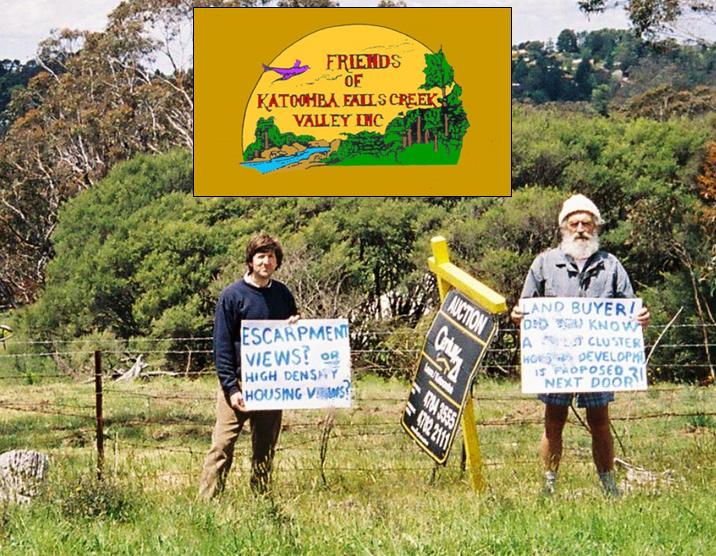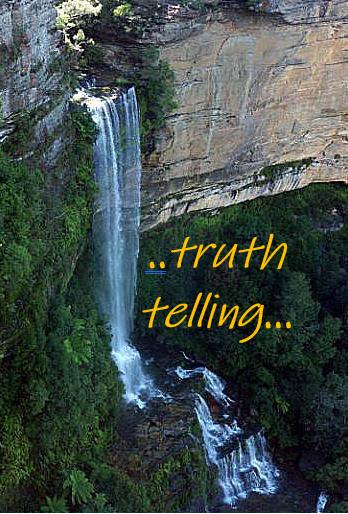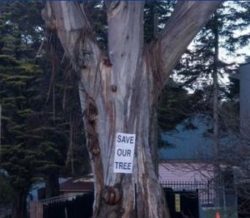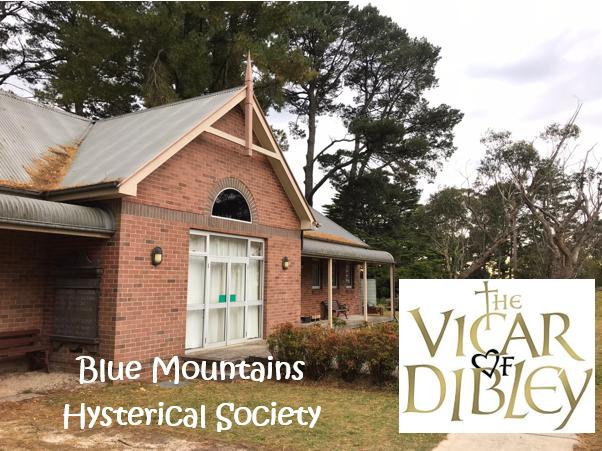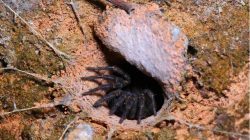Archive for the ‘South East Corner (AU)’ Category
Monday, March 19th, 2018
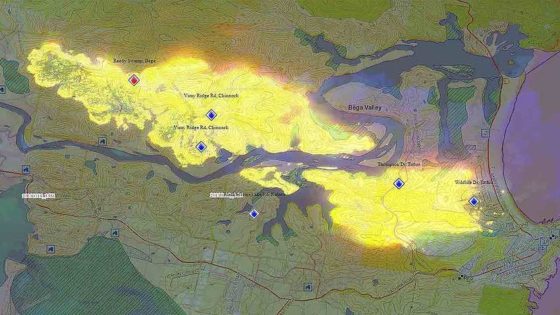
Bushfire Scenario Was Not Rocket Science
On Sunday 18th March 2018, the weather in Bega and nearby coastal Tathra was forecast to be a very hot 38 degrees Celsius, low humidity and high westerly gusting winds. So a Total Fire Ban was appropriately declared the afternoon prior by New South Wales Rural Fire Service Commissioner Shane Fitzsimmons. The Fire Danger Rating was set locally to just “High”.
Around midday a fire started on or near the rural property at 580 Reedy Swamp Road, situated about 8km SE of Bega on the western edge of the Tanja State Forest, with the outskirts of Tathra situated on the eastern edge just 4km downwind.
When will the ignition source be published so devastated Tathrans learn the truth?
It was a simple fire in bushfire terms. It started adjacent and upwind of state forest bushland in hot windy conditions and kept going in the same direction as the wind blew it until the wind dropped. It was wholly predicable, not rocket science. So the circumstances are indeed suspicious, but we expect a cronyistic cover up.
The nearest bushfire brigade is the Tarraganda Fire Shed on Tarraganda Lane about 6km NW of the ignition site, but government expects local volunteers to respond on standby, under-resourced to defend their community last minute with no financial compensation.
Four kilometres east is the outskirts of Tathra along Thompson Drive across the Bega River. This is locally referred to as the Tathra River Estate – a Bega Council approved satellite suburb invading remnant native habitat.
The Chronically Avoided Questions
- There was no lightning, so what was the ignition source on this day of declared Total Fire Ban?
- How long did it take the RFS to discover the fire after its estimated ignition time?
- How did the RFS learn about the ignition? Proactive real-time geo-stationary low-orbit satellite with infrared camera or just a reactive public call to ‘000’?
- How long did it take the RFS to arrive on site to suppress the fire? We’re talking mum and dad volunteers here, apparently arriving on the fire ground at 12:43pm to do squat.
- What is the point of having fire trails throughout the Tanja State Forest if when there is a bushfire emergency, they are too dangerous to use?
- When did the RFS realise that the gusty winds would spot embers over the Bega River and impact Tathra? When the embers spotted over the river?
- What bushfire preparations and asset protection zones had been in place for Tathra, if any?
- Given that Tathra was obviously bushfire prone, which homes were Bushfire Attack Level assessed and compliant?
- Where was the RFS Erickson S-64 Air-Crane purpose designed helicopter Elvis with its 9,500 litre water dumping capacity?
- Where was the RFS C-130 Thor with its 44,000 litre water dumping capacity? It cruises at 540kph, so from its base at Richmond it could have been deployed and effective over the active fire edge imminently set to impact Tathra within an hour – 360km as the crow flies! – if they were military standard professional.
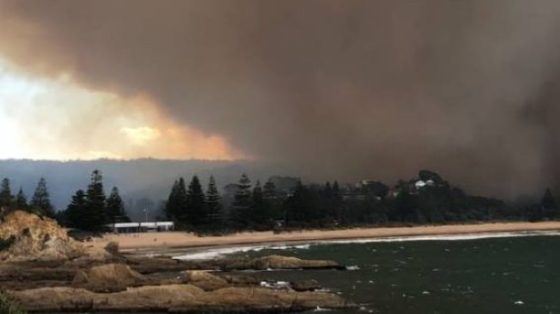 The under-resourced pre-1939 volunteer model for the bushfire fighting is a repeated failure The under-resourced pre-1939 volunteer model for the bushfire fighting is a repeated failure
Another Promised Wildlife Sanctuary Goes Up In Smoke
So the fire was left to burn into the Tanja State Forest because, according to the RFS cultural scarce resource mindset, it was not immediately threatening property. She’ll be right. A bit of unauthorised hazard reduction wouldn’t go astray. What habitat?
The fire was only incinerating the flora reserve which provides habitat for one of the last Koalas communities along the Sapphire Coast. The RFS dubbed the fire the Reedy Swamp Fire or the Tarraganda Fire. Residents were only advised to “Watch and Act”, whatever that means.
Then mid-afternoon the wind picked up as per the usual diurnal wind variation profile. So with 38 degrees Celsius and 30 kph plus nor-westerly winds, the fire raced out of control through dense bushland toward the western outskirts of Tathra on the coast. At no time did the fire front change direction. It was heading towards Tathra from the outset.
Incident logs from Sunday show Fire and Rescue NSW, a state government agency, offered additional emergency brigades and assistance at 12:34pm in response to a flood of Triple Zero calls from the area. Those offers were declined before the agency attempted to offer more crews again at 12.58pm – again being rejected.
RFS Deputy Commissioner Rob Rogers said while the fire was burning in remote mountainous terrain, “it would have been dangerous to have [Fire NSW] there”.
The purpose of fire trails? Habitat reduction.
Rural Firefighting Dysfunction
She’ll be right. It was only at 3.40pm that authorities from the Rural Fire Service did request extra help, issuing a priority request for all available assistance, as the fire front rapidly approached Tathra.
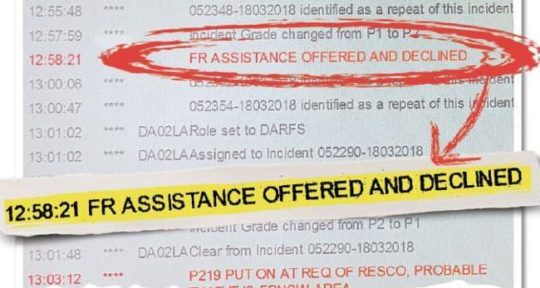
Shortly after 2.30pm the bushfire intensified as winds picked up. By 4pm the fire had hit Tathra and NSW Rural Fire Service volunteers warned residents it was too late to leave.
But it wasn’t the 7km bushfire front misreported by the media. The early spread of the bushfire started at around 500m wide and then spread to about a 1500m wide front, spotting ahead as it was fanned by the gusty WNW winds. The bushfire front tracked from the ignition near Reedy Swamp downwind 7 km toward Tathra Head at the coast. The only thing seriously stopping the bushfire was the weather or the sea.
RFS deputy fire commissioner Rob Rogers said the bushfire quickly got out of control after it started yesterday afternoon. “It jumped very quickly to a place called Thompson Drive and that was where the first home was impacted and it just really quickly ran then into the main part of the town,” he said.
By 4:38 pm the RFS was reporting: “EMERGENCY WARNING – Reedy Swamp fire (Bega LGA) – Fire impacting on #Tathra. Seek shelter. It is too late to leave.”
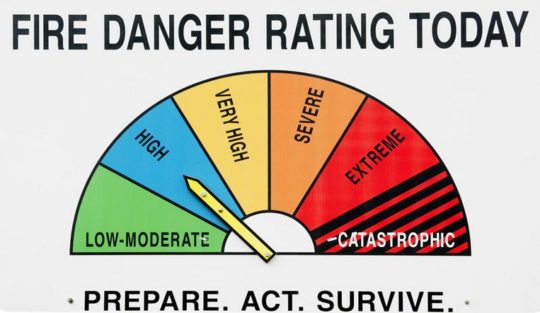 What is the point of having a Catastrophic rating if it isn’t used? What is the point of having a Catastrophic rating if it isn’t used?
Deputy Commissioner Rogers said dealing with nature was not always “an exact science”. “There has been dozens of hazard-reduction activities in that area,” he said. “There was one that was only two or three years’ old and the fire went straight through that burn as well.
This time 65 homes, 35 cabins and caravans destroyed, and dozens more damaged. Only last January the Tathra Launderette caught fire and destroyed the premises as well as the adjoining Bliss Stylists hairdresser and Little Bottler Tathra Cellars.
But criticism is taboo because the government sends in volunteers, who are automatically beyond reproach. The politicians are very quick to remind us at every bushfire aftermath.
Different Fire, Same Incompetence
The RFS in hindsight are reporting it as “catastrophic” and “a perfect storm”. It’s frankly a bit late Shane Fitzsimmons and are they now furiously shredding their communication records?
“It will never be the same again,” said Renata Boulter, a Tathra resident of 26 years.
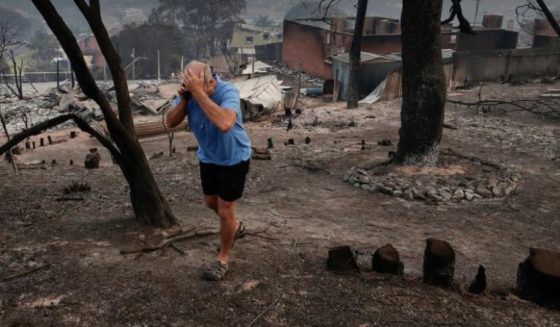 Trust government’s used and abused volunteer force with your livelihood? Trust government’s used and abused volunteer force with your livelihood?
The insurance damage bill will be in the hundreds of millions, again, and that ignores the human, livestock and wildlife cost ignored by a sound bite media. Ina few weeks the ghoulish media filming amongst the ruins in their shiny hi-vis wear will have packed up and moved on.
It’s another Dunalley (Forcett bushfire) (2013), another Yarloop (2016), another Mundaring (2018), another Marysville (2009), Canberra (2003), Cockatoo (1983), Anglesea (1983), Hobart (1967), Leura (1957). On each occasion, the bushfire had been not threatening houses and so wrongly left to burn in some cases for days, then the wind picked up in the afternoon as it usually does and it was all too late.
And the lawyers will no doubt be getting in for their pound of flesh, just like Maurice Blackburn profited $100 million in fees out of the victims of Victoria’s 2009 Black Saturday bushfires. Tathra victims would be well advised to read up on Garry Angus, Kinglake victim, who suffered $4.2 million in economic losses. But after six years trustful waiting, Maurice Blackburn offered him a compensation cheque for $120,000. He sent it back to them in disgust. The lawyers also exposed the victims compensation to a $20 million tax liability – so the government to a cut from the victims compensation as well.
“The whole thing was flawed right from day one. The $494m (for Kilmore East-Kinglake victims) that they settled on was never going to be enough to help people. It needed to be three times that amount.”
(Read Postscript below).
Disaster Waiting to Happen..again
The western outskirts of Tathra, known as Tathra River Estate, bore the brunt of the bushfire. It was subdivided and developed and built out from 2013. The NSW Government Department of Planning and Infrastructure and the Bega Council happily approved the ‘Planning Report: State Environmental Planning Policy No. 71 (Coastal Protection) Master Plan: Tathra River Estate, dated June 2012.
Concerns over the current inadequacies of bushfire access was raised during submissions, as the well as the cumulative impact of additional dwellings and the need for emergency access in the event of a bushfire.
Many of the residential houses decimated by the fire were built between the 1960s and 1980s, in cheap and nasty asbestos. No bushfire tolerance. She’ll be right.
The provision of Asset Protection Zones, connection to the fire trail network and emergency access around the edge of the development apparently addressed many of the concerns. It was then up to Bega Council “to consider other matters in a bushfire emergency strategy.” What did Bega Council do or not do? We suspect cronyistic developer corruption.
The NSW RFS raised no objection to the Master Plan. Yesterday, Tathra River Estate (Thompson’s Drive or Estate) as well as similarly recently approved housing subdivisions extending into the native bushland such as Wildlife Drive and Sanctuary Place, bore the bushfire frontal attack.
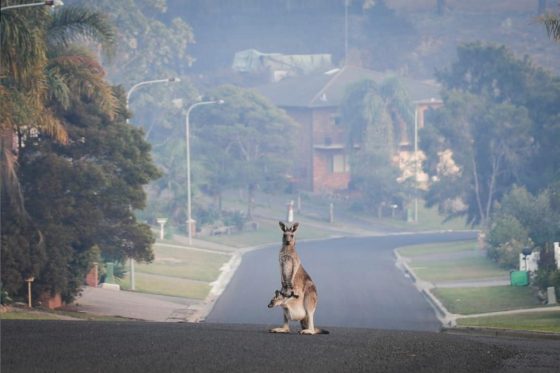 It’s called ‘Wildlife Drive’ for a reason. It’s called ‘Wildlife Drive’ for a reason.
The residential development encroaches upon Tanja State Forest – established in 2017 to protect wildlife
There is shared culpability here, and how did they get home and contents insurance?
 Tathra River Estate/Thompson’s Estate (bottom right of image) – juxtaposed next to Tanja State Forest Tathra River Estate/Thompson’s Estate (bottom right of image) – juxtaposed next to Tanja State Forest
(This is an old image – more development has been allowed since)
It costs $20,000 a day to keep the Elvis air crane on stand-by and an additional $11,000 a day to operate. This extrapolates to $11 million a year to have Elvis ready and able to seriously suppress bushfires. Sounds like a lot of money but the economic loss and emotional cost besetting Tathra residents?
In 2015, the NSW Rural Fire Service unveiled its latest fire fighting weapons, including a monstrous-sized former RAAF C-130 Hercules converhuman ted water-bombing tanker capable of dropping up to 44,000 litres of water on any bushfire any time. It costs a bomb, but what cost Australian livelihoods?
The official economic cost of the Dunalley (Forcett) bushfire was $100 million, the Yarloop bushfire $45 million, Marysville $300 million and Canberra $300 million.
Melbourne University’s follow up study into the human aftermath of Victoria’s 2009 Black Saturday bushfires reported a quarter of survivors still experiencing serious mental health problems six years later, including affected children. (Read report below under Further Reading’)
“The reality of the disaster and its aftermath formed the ongoing backdrop of children’s daily lives. Children from a very young age through to older youth experienced anxieties and upheavals at home, in school, in sport, in friendship groups and in the community.
“She had so much trouble going back to school. She couldn’t think, concentrate at all. Everything seemed irrelevant that she was doing and they tried so hard. They were very helpful but she had a lot of trouble with just fitting in with the kids that she knew before there. They weren’t understanding her and she just felt that all their problems were very trivial.”
(Parent)
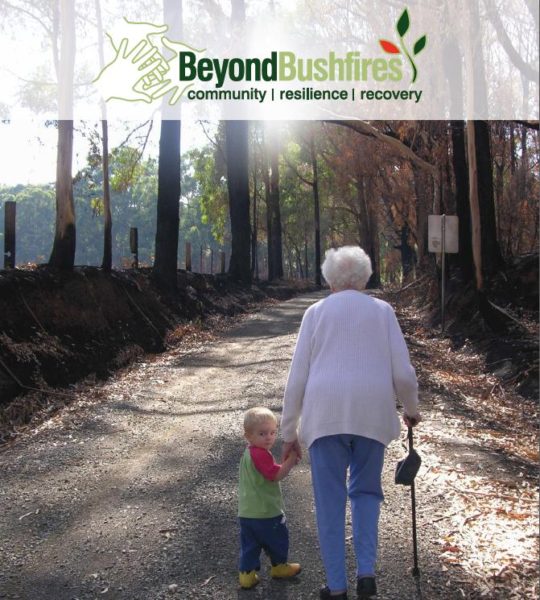 Photo by Ngaire Walhout Photo by Ngaire Walhout
Lessons To Be Blocked by Cronyism..again
Of course there will be another government enquiry, so the government is seen to given a damn. There are the same number of government enquiries as there have been bushfire tragedies since the Black Friday back in 1939. It concluded – “Mistakes We’re Made”, and then the report gets filed and bushfire fighting returns to business as usual and set to repeat history.
The 1939 Black Friday fires in Victoria burned almost two million hectares, claimed 71 lives and destroyed more than 1,000 homes, including entire townships. In adjusted terms, these fires cost some $750 million.
On 1983 Ash Wednesday fires in Victoria and South Australia claimed 75 lives, more than 2,000 homes and over 400,000 hectares of country. Total property losses were estimated to be over $400 million. Between 1967 and 1999, bushfires in Australia resulted in 223 deaths and 4,185 injuries, and a total economic cost of more than $2.5 billion. Victoria’s Black Saturday in 2009 cost $4.4 billion and 173 lives.
For Tathra yesterday, it could and should have been responsible, militarily heroic, and quite beautiful – professional fire suppression like Sydney gets, where emergency professionals have proper resources at their disposal, are properly remunerated, and so residents entrust the firies to save their homes and family.
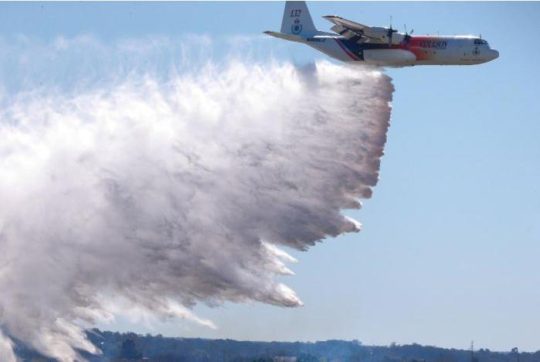 Where was it parked this time? Where was it parked this time?
In 2017 the NSW Government delivered a $4.5 BILLION surplus, so they are not exactly struggling.
Tathra is a microcosm of Victoria’s bush-enclosed Mornington Peninsula coastal residence west of Rosebud; timber and fibro shacks enveloped in a tinder dry tea-tree forest – in a bushfire Forest Fire Danger Index scary scenario – another catastrophic crematorium waiting to happen.
What does the land manager National Parks Service say about Tanja State Forest? It is part of the Murrah Flora Reserves which encompasses 4 areas covering nearly 12,000 hectares and include Murrah, Mumbulla, Bermagui and Tanja flora reserves along the New South Wales Sapphire Coast. The Murrah Flora Reserves were created in March 2016 and are significant to the local Aboriginal Yuin People who own neighbouring Biamanga National Park. They also provide an important conservation role, as habitat for the last significant koala population on the NSW South Coast and other threatened species, such as the long-nosed potoroo, yellow-bellied glider and the powerful owl.
Of course it was “overgrown”. It’s called wildlife habitat. And firies, it’s scarce and valuable and worth defending. It is not expendable. yet another 1200 hectares of native habitat set aside for supposed sanctuary has been incinerated. It was a defacto RFS hazard reduction again gone wrong.
NSW National Parks and Wildlife Service:
“The national and state forests within the Sapphire Coast are home to some of the most iconic views and breathtaking landscapes in Australia. The South Coast’s outstanding national park system offers visitors a wide choice of opportunities to discover spectacular landscapes, from dense forests to quiet, solitary beaches; from cool, silent rainforests to colourful, alpine wilderness wildflowers. The national parks a diversity of unspoiled habitats and ecosystems which offer refuge to unique, and often ancient, plants and animals found nowhere else on Earth.”
Hypocrites!
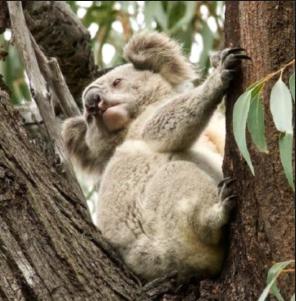 Koala in the Murrah Flora Reserve, probably incinerated. Photo by David Gallan. Koala in the Murrah Flora Reserve, probably incinerated. Photo by David Gallan.
Source: Far South Coast Conservation Management Network
^http://www.fsccmn.com/?p=2151
Footnotes
‘Angry survivor returns Black Saturday payout to ‘only winner’, Maurice Blackburn‘, 20170501, by Reporter Pia Akerman published in The Australian Newspaper, ^https://www.theaustralian.com.au/in-depth/bushfires/angry-survivor-returns-black-saturday-payout-to-only-winner-maurice-blackburn/news-story/ea9fe705b2616852235851e62424adea.
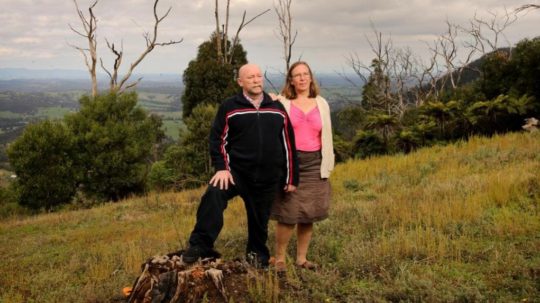
“I’ve lost the value of my business, I’ve lost everything.”
Garry Angus and Anne Salmon on a block they own outside Kinglake. Photo by Stuart McEvoy
‘As cheques from the record-breaking Black Saturday class actions finally began flowing to bushfire survivors in December, many of the victims welcomed the payments as the end of another chapter in their emotional and financial recovery.
Not Garry Angus. He, with an unquantified number of the thousands of claimants who joined the lawsuits, remained angry about Maurice Blackburn’s handling of the cases. The accountant from Pheasant Creek, just outside Kinglake, decided to put his money where his mouth is and sent back his cheque for $120,000.
Now he is launching a website for fellow survivors to register their complaints about Maurice Blackburn’s administration of the settlement scheme. He hopes support from other aggrieved claimants will bolster his bid for a judicial review of the $494 million Kilmore East-Kinglake settlement and the $300m settlement for the Murrindindi-Marysville fire, announced in 2014 and 2015 respectively.
“The only winners out of this have been Maurice Blackburn,” Mr Angus said. “The whole thing was flawed right from day one. The $494m (for Kilmore East-Kinglake victims) that they settled on was never going to be enough to help people. It needed to be three times that amount.”
Like a number of other bushfire survivors who have spoken publicly, Mr Angus is angry at the fees Maurice Blackburn has stripped from the settlements — more than $100m — and the Australian Taxation Office’s claim that the firm has acted unusually to expose the funds to a tax liability of about $20m. He is also furious at how his case was personally handled, claiming that the firm was lax in communicating with him, and only junior staff dealt with him (even misspelling his name on his formal assessment notice).
Before the February 2009 bushfires, Mr Angus owned and managed an accounting firm that employed eight people. He owned four investment properties around the Kinglake area, losing two completely to the blaze.
He brought a 2000-page tome of his financial records with him to his meeting with assessor Neil Rattray, and says the barrister was clearly overwhelmed and admitted he might not be the best person to handle this complex case.
Mr Angus’s claim for $4.2m in losses — largely based on future earnings from his firm, which he closed while struggling with post-traumatic stress disorder in the fires’ aftermath — was dismissed by Mr Rattray. The barrister did not accept he would suffer from any future loss of earnings or earning capacity, arguing that his business had been struggling and there was “no real suggestion” the company would be successful in the future.
In a submission to Supreme Court judge Jack Forrest, who oversees the Kilmore East settlement scheme’s administration, Mr Angus has accused Maurice Blackburn of failing in its duty of care, and asked for an independent review.
Maurice Blackburn has stood by the assessment, saying Mr Angus missed his chance to formally request a review (for which the firm charges $3800 if the finding is against the claimant).
“Given Mr Angus never objected or asked for a review during the assessment process, it’s an odd protest to now hand back a substantial cheque because of a desire to obtain more money,” a spokesman said.
Mr Rattray told The Australian he could not comment on Mr Angus’s claims, but in the reasons for his assessment, he noted that Mr Angus had treatment for depression and panic attacks before the bushfires. Since the fires, he has been suicidal at times, needing extensive medical treatment and occasional hospitalisation.
“It has psychologically scarred me for the rest of my life,” Mr Angus said. “I’ve lost the value of my business, I’ve lost everything.’’
Further Reading:
.
[1] ‘Bushfire emergency, houses destroyed in Bega, Tathra area‘ 20180319, by Ben Smyth, in The Land, ^http://www.theland.com.au/story/5290860/bushfire-emergency-houses-destroyed-in-bega-tathra-area/
.
[2] Murrah Flora Reserves Draft Working Plan 2017, by NSW National Parks and Wildlife Service, and Forestry Corporation (NSW Government), ^http://www.environment.nsw.gov.au/research-and-publications/publications-search/murrah-flora-reserves-draft-working-plan
.
[3] Submission on Murrah Flora Reserves Draft Working Plan, 20180131, by South East Conservation Alliance Inc. ^www.serca.org.au/submissions/2018/thompson1.pdf
[4] Tathra River Estate DOP Assessment Report 2012 >https://www.habitatadvocate.com.au/wp-content/uploads/2018/03/Tathra-River-Estate-DOP-Assessment-Report-2012.pdf
.
[5] ‘Tasmania’s Forcett Fire 2013 – 16 questions‘, 20130203, by The Habitat Advocate, >https://www.habitatadvocate.com.au/?p=21167
.
[6] ‘Culpable Negligence of Tasmanian Burn Offs‘, 20130105, by The Habitat Advocate, >https://www.habitatadvocate.com.au/?p=20848
.
[7] 2013 Tasmanian Bushfires Inquiry Full Report, Vol. 1, >www.dpac.tas.gov.au/__data/assets/pdf…/1.Tasmanian_Bushfires_Inquiry_Report.pdf
.
[8] Beyond Bushfires: Community Resilience and Recovery, Final Report 2016, by the University of Melbourne, ^http://beyondbushfires.org.au, >https://www.habitatadvocate.com.au/wp-content/uploads/2018/04/Beyond-Bushfires-Final-Report-2016.pdf
.
[9] Threats from Bushfire, article series by The Habitat Advocate, >https://www.habitatadvocate.com.au/?page_id=6954
.
Tags: fire volunteers, Reedy Swamp Fire, RFS, Rural Fire Service, Tanja State Forest, Tarraganda Fire, Tathra, Total Fire Ban
Posted in Endangered Wildlife (EN), Koalas, Owls, South East Corner (AU), Threats from Bushfire | No Comments »
Add this post to Del.icio.us - Digg
Friday, May 31st, 2013
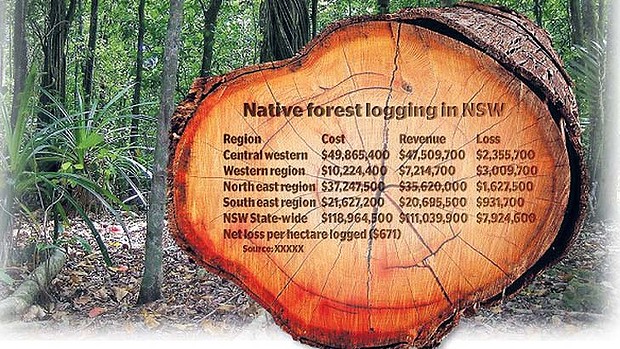 Forests NSW has been rebranded the Forestry Corporation of NSW for what wasteful reason?
It continues to make massive losses and should be wound up, not rebranded.
It destroys native habitat and makes an $8 million annual loss in the process.
This makes forestry not a commerical business, but a Costly Cult of Logging Losers. Forests NSW has been rebranded the Forestry Corporation of NSW for what wasteful reason?
It continues to make massive losses and should be wound up, not rebranded.
It destroys native habitat and makes an $8 million annual loss in the process.
This makes forestry not a commerical business, but a Costly Cult of Logging Losers.
.
<<Taxpayers in NSW are losing money to subsidise the logging of native forests, at an average cost of $671 a hectare ($8 million p.a.), undermining a parliamentary report calling for a massive increase in such logging.
According to new figures, each of the four native forest operations run by the Forestry Corporation of NSW made a loss, combining for a total loss of $7.9 million.
Fees paid to contractors to harvest and haul timber, staff and administration costs for forestry management reached $119 million last year, but revenue from pulpwood and sawlogs was just $111 million.

come…

Rebranding with a chainsaw image and new website.
Like the RTA-come-RMS…same organisation, same management, same Baby Boomer culture, different in name only.
That was a big fat waste of money Premier Barry O’Farrell.
.
A state parliamentary inquiry, dominated by the Shooters Party and the Nationals, has recommended an increase in logging of native forests to keep loggers in jobs. But Greens MP David Shoebridge said the data revealing the losses, which was released in response to questions on notice by the Greens, showed any expansion of logging would ”cost taxpayers dearly” and doesn’t make economic sense.
”Wood chipping native forests causes enormous environmental destruction – it’s not like health or education where people expect the government to subsidise a social good,” said Mr Shoebridge. ”Rather than expanding native forest logging, as the Shooters Party and the Nationals are calling for, the government should be actively transitioning away from native forests to plantations.”
Forests NSW, which pays a dividend to the state government, was corporatised in January with the aim of stemming the losses from the native forestry operations, which are being cross-subsidised by profitable plantation logging.
Plantation profits reached $32 million in the 2011/12 financial year, but the dividend paid to the government was cut in half by the loss in the native forests division.
A Forestry Corporation spokeswoman said: ”It is true that in recent years the native forest operations of the former Forests NSW have been loss-making in pure commercial terms.”
She said all aspects of the business are now being reviewed by new management, and new revenue streams and products have been identified, including rocks, gravel, commercial recreation, permits for telecommunications towers and tourism, to generate money.
.
Forestry is a Costly Cult of Logging Losers
.
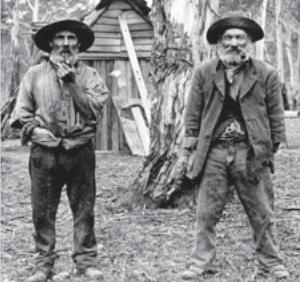 Timber Getters
“A proud a rich history”.. in logging native forests and destroying native habitat for personal profit
What’s Changed?
These days they do science degrees and come out calling themselves ‘foresters’. Timber Getters
“A proud a rich history”.. in logging native forests and destroying native habitat for personal profit
What’s Changed?
These days they do science degrees and come out calling themselves ‘foresters’.
.
But there are no plans to stop logging in native forests because the state government is locked into contracts with long-term wood supply commitments.
”The timber industry is often the main employer and source of economic activity in rural and regional areas,” the spokeswoman said.
Mr Shoebridge said the industry was pushing for the government to increase the volume of wood harvested from 160,000 cubic metres to 269,000 cubic metres a year.
”To feed that massive 80 per cent increase will require logging more than 40,000 hectares of NSW forest every year from protected reserve areas and overexploited state forests.”
Logging in Forestry Corporation’s central region native forests near Wauchope lost $2.36 million in 2012. The western region near Dubbo lost $3 million, the north-east region forest near Coffs Harbour lost $1.63 million, while the south-east region near Batemans Bay lost $931,700.
A Forestry Corporation spokeswoman said if logging in native forests was stopped, taxpayers would have to foot the bill for the management of land.>>
.
[Source: ‘Hatchet job on native forest logging’, 20130519, by journalist Kirsty Needham, Sydney Morning Herald, ^http://www.smh.com.au/nsw/hatchet-job-on-native-forest-logging-20130518-2jtcf.html]
.
[Ed: So be it. The $8 million in annual losses would quickly pay for the legal payout of the wood supply contracts. It’s about political will, and Barry is a teddy bear.]
.

So the timber industry in New South Wales is now pushing to be allowed to log up to a million hectares of national parks so it can harvest the volumes promised in unsustainable timber supply contracts. This outrageous move has occurred at the same time that the NSW Government is conducting a secret review of forestry regulations and timber supply options.
Throughout this review, the timber industry has been campaigning hard to bring in damaging reversals of the hard won forestry regulations that protect our threatened animal and plant species and their habitats.
Premier Barry O’Farrell must resist pressure from the Shooters and Fishers Party, and from within his own government, to make more forests available for logging and other damaging changes to the forestry regulations that protect our unique wildlife and the areas they call home.
It is unthinkable that the O’Farrell Government would allow the destruction of areas like Nightcap National Park so the Forestry Corporation can turn a profit.
.
[Source: Kate Smolski, Campaigns Director, Nature Conservation Council of New South Wales, ^http://www.nccnsw.org.au]
.
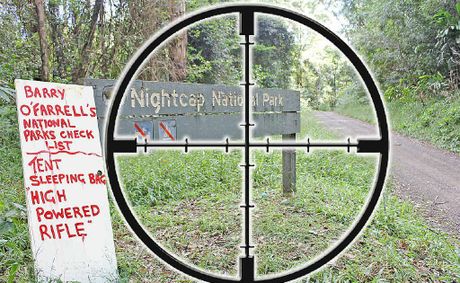 Nightcap National Park in the sights of cowboy hunters Nightcap National Park in the sights of cowboy hunters
.
And the shooting threat hasn’t gone away…
<<Several North Coast national parks have been included on a “hit list” of parks to be considered for recreational shooting.
Last week Premier Barry O’Farrell announced changes to the Game and Feral Animal Control Act (2002) that would allow 79 of the state’s 799 national parks, nature reserves and conservation areas to be used by licensed shooters. The list includes the Nightcap, Richmond Range and Yabbra National Parks.
The announcement has been widely criticised by environment groups and the Opposition as a “backroom deal” to secure the support of the Shooters and Fishers Party in return for support to privatise the state’s electricity assets.
Premier O’Farrell said prior to the last election: “There will not be a decision to turn our national parks into hunting reserves.”

Vice president of the ^North Coast Environment Council Mr Jim Morrison said he was “absolutely outraged” by the election backflip.
“We’re disappointed because we were given assurances before the election this would not happen,” he said. “I’ve got little faith in the O’Farrell government now to manage the environment… I think the difficult issue will be compliance because when there are people running around with guns, it will be impossible for National Parks staff to know who is legal and who isn’t… I’m frightened people who visit some of the more remote parks where there aren’t any services will be turned off visiting for activities such as bushwalking.”
Mr Morrison said he also feared a resurgence of “cowboy shooting activity” in remote areas. “It’s a bad message to be supporting a blood sport and I don’t believe it will be an effective way to do feral animal control. It should be managed by park staff.”
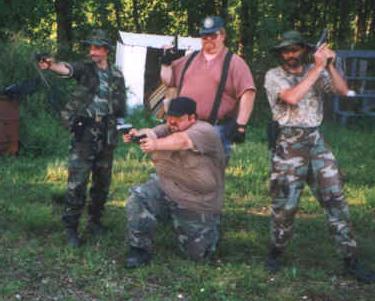
The NSW Public Service Association (PSA), which represents park rangers, has directed its members not to assist with any activity involved with establishing recreational hunting in national parks in NSW.
PSA General Secretary Mr John Cahill:
.
“Our members have expressed serious concerns about the danger to themselves and the community when shooting is allowed in bushland popular with walkers and picnickers. Our members have been working very hard to control and manage feral animals in parks.
Recreational shooting will compromise the professional and scientifically proven feral animal control programs run by National Parks staff, placing native plants and animals at risk.
“Industrial action like this is not a decision we take lightly but we simply cannot let the State Government’s compromise of our national parks to go ahead.”
.
Spokesperson for the North East Forest Alliance (^NEFA) Dailan Pugh issued a statement calling for the Federal Government to intervene.
“The fact that Premier O’Farrell can say in one breath that they will exclude World Heritage, and in the other identify six World Heritage listed parks for shooting, shows how ill-conceived his backflip is… The Federal Government needs to intervene to over-ride the State Government’s announced intention to allow shooting in world-heritage properties,” Mr Pugh said.
CEO of Northern Rivers Tourism Russell Mills issued a cautious warning. “My initial view is that national parks like the Nightcap that are part of the World Heritage and their primary
drawcard is the pristine nature of the wilderness areas… If National Parks (management) are considering the pros and cons of shooting, I hope they take into consideration the motivation for visiting parks, and I believe they would.”
Rob Andrews from the Northern Zone Hunting Club said he had been “deluged” by up to six calls a day since the Premier’s announcement from people wanting to know how to go about getting licences.>>
.
[Source: ‘Parks in shooters’ sights’, 20130607, by journalist Andy Parks, Echo News, ^http://www.echonews.com.au/news/parks-in-shooters-sights-govt-to-allow-hunting-in-/1407811/]
.
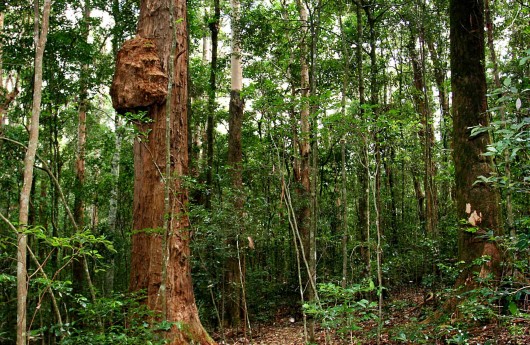 Richmond Range National Park
Targeted for logging and shooting by its custodian, the New South Wales Government
[Source: ^http://www.nationalparks.nsw.gov.au/richmond-range-national-park]
Richmond Range National Park
Targeted for logging and shooting by its custodian, the New South Wales Government
[Source: ^http://www.nationalparks.nsw.gov.au/richmond-range-national-park]
.
Further Reading:
.
[1] >Forestry Bill 2012 Explanatory Note.pdf (380 kb)
.
[2] ^Forests NSW Annual Report 2011-12.pdf (10.4 MB)
.
[3] >Forests NSW Facts and Figures 2011-12.pdf (2.8 MB)
.
[4] ^Forests NSW Annual Report 2010-11.pdf (7.6 MB)
.
[5] >Forests NSW Facts and Figures 2010-11.pdf (3.5 MB)
.
[6] >Forests NSW Annual Report 2009-10.pdf (6.2 MB)
.
[7] >Forestry in NSW 1996.pdf (1.5MB)
.
Tuesday, November 27th, 2012
 Shrinking Koala Habitat – completely dependent upon the whims of Australians, if we give a toss. Shrinking Koala Habitat – completely dependent upon the whims of Australians, if we give a toss.
Being systematically destroyed by O’Farrell Government Loggers across coastal New South Wales, Australia
.
Koala Habitat is being trashed across New South Wales
[Source: The following article was published as ‘When trees fall in the forests’, by Ben Cubby, Sydney Morning Herald, 20101112, ^http://www.smh.com.au/environment/conservation/when-trees-fall-in-the-forests-20101111-17pgt.html]
.
<<The dull, grinding roar of logging trucks has become background noise in the hills around Eden, on the New South Wales south coast. Equally familiar is the sight of people photographing the loggers’ loads as they are hauled down to the local woodchip mill and on to ships bound for Japan. The campaigners are looking for signs of tree trunks that have hollows and may have supported native sugar gliders or owls.
About 1,200 kilometres north, in the subtropical rainforest near Casino, botanists and zoologists are poring over maps and Google Earth, tracking breaches of logging conditions – trees cut down inside protection zones, trees felled that supported endangered wildlife or nourished other flora.
The tit-for-tat battle in the forests has led to frustration on all sides, with forestry workers complaining of ”manic hatred” directed at them. Anti-logging activists say the damage to state forests is systematic and routine, as established rules in the NSW Forest Agreements are disregarded.
”It’s not exactly a surprise to us that there are so many breaches because the fox is in charge of the hen house,” says Lisa Stone, a campaigner with South-East Forest Rescue. ”It keeps happening over and over again. You have got areas where they are supposed to be taking out single trees and then you go there and it’s practically clear-felled.”
For each state forest targeted for logging, a plan must be drawn up that leaves some trees untouched, in accordance with the ”environmental protection licences” issued to logging contractors working for the state government agency, Forests NSW.
.
What the hell is Government’s Forests NSW doing to Wildlife Habitat?
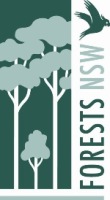
Forests NSW Greenwash:
.
“Forests NSW is committed to ensuring a supply of timber from NSW State forests today and into the future while also protecting other forest values such as biodiversity, clean air and water and public access for recreation. We are committed to running a safe and profitable business for the people of NSW.”
“The NSW (O’Farrell) Government has announced it will make Forests NSW a state owned corporation (SOC). Forests NSW will remain publicly owned and the nature of the business and business relationships will remain largely the same but the governance structures will change to improve the organisation’s commercial performance.
As a state owned corporation under the direction of a skilled commercial board, Forests NSW will be able to focus sharply on its core business of growing and harvesting timber to meet the community’s needs for hardwood and softwood products while still providing recreational opportunities for the people of New South Wales.”
[Source: ^http://www.forests.nsw.gov.au/]
.
Ed: So to the O’Farrell Government the forests are only about human needs – a babyboomer mindset, just like in the Old Testament. “..And God said unto them be fruitful, and multiply, and replenish the earth, and subdue it: and have dominion over the fish of the sea, and over the fowl of the air, and over every living thing that moveth upon the earth.” [Bible, Old Testament, Book of Genesis 1:28] ..and humans have been self-righteously buggering the planet ever since.
.
<<The many-layered oversight system produces a lot of work for the handful of NSW Department of Environment, Climate Change and Water staff, some of whom have found themselves visiting the same logging sites repeatedly.
Forests NSW stressed that a warning letter can refer to separate breaches, which partly explains why the number of warnings issued to Forests NSW is so much lower than the number of times rules get broken.
Nonetheless, department staff have told the Herald that guidelines are often applied indifferently by loggers and some contractors are serial offenders. Forests NSW has also lost staff through voluntary redundancy this year which, some workers argued, affects its ability to police logging contractors.
A spokeswoman for the Environment Department said logging licences contained ”strict provisions to protect the environment, threatened species and its habitat”. Audits of logging operations are carried out every month as part of its compliance program.
”[The department] is concerned about the number of recent alleged breaches being reported in the south-east of NSW and in response is conducting several comprehensive field audits of Forests NSW work in the region. If any of the alleged breaches are found to be substantiated then the [department] will take appropriate action.”
New spice has been added to the deluge of investigations by the recent so-called ”peace deal” in Tasmania, which saw major logging companies, including Gunns, agree to stop logging in old-growth native forests. The deal also included an effective end to large-scale burning of native timber as a source of renewable energy, a process that is now permitted in NSW. The National Association of Forest Industries said it would oppose any effort to transfer the Tasmanian deal to mainland Australia.
A woodchip company, South-East Fibre Exports, is planning to build the state’s first wood-fired electricity plant at Eden, burning ”offcuts”. The company says opposition to its power plant is driven by people with the broader agenda of ending logging in native forests altogether. This seems likely to be true. South-East Fibre Exports blames anti-logging campaigners for setting up a fake website that mocks the company’s proposal, and a campaigner against the power plant, the former fashion designer Prue Acton, found an electronic bugging device in her home earlier this year. No one knows who is responsible for planting the bug, and there is no suggestion it is linked to the logging dispute. Police are investigating.
The NSW Primary Industries Minister, Steve Whan, said he had faith in the forestry companies and Forests NSW. ”Allegations of ‘systematic damage’ are overstated,” says Whan. ”The majority of the alleged breaches in question are minor in nature – with little to no impact on the environment.”
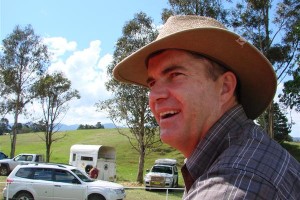 Former NSW Labor Minister for Minerals and Forest Resources, Steve Whan,
who also had Primary Industries, Emergency Services and Rural Affairs – i.e. politically imposed conflicts of interests. Former NSW Labor Minister for Minerals and Forest Resources, Steve Whan,
who also had Primary Industries, Emergency Services and Rural Affairs – i.e. politically imposed conflicts of interests.
.
In southern NSW, the forestry organisation is regularly scrutinised and was operating within the rules.
”Forests NSW southern region has received no penalty notices and not one case has been brought to prosecution for at least the past three years. ‘As a local member in the area as well as the Minister for Forest Resources, I personally welcome the intense environmental scrutiny that forestry operations in the area are subjected to. It is very important that any logging operations in the region comply with all the environmental conditions in place.”
Documents maintained by Forests NSW staff show there were 13 breaches recorded in south-eastern NSW last year.The breaches include cases of ”lack of care taken by operator”, ”operator did not see marking tape” and ”poor rigour in completing surveys”. Some could be explained by mishaps such as a vehicle slipping on a steep hillside into a protected area. In one case a logging contractor cut down trees in an area marked as ”old growth forest” because a global positioning system device had run out of batteries.
Of the 13 recorded incidents, eight resulted in verbal warnings to forestry contractors and one, in which the estimate of damage made by environment department staff differed from Forests NSW’s, resulted in a warning letter. Environmental damage was in every case assessed to be ”nil” and no remedial action was taken.
In part, the mistakes could be put down to forestry workers working to tight deadlines in rugged terrain.
But anti-logging activists are not prepared to be that charitable. The parallels with the situation in northern NSW are remarkable. In the state forests around Casino and Tenterfield, a group called North-East Forest Alliance has identified damage to stands of trees inhabited by koalas, stuttering frogs, sooty owls, powerful owls, golden-tipped bats and yellow-bellied gliders. The same types of breaches are evident, with contractors failing to follow guidelines about properly marking up vulnerable trees. Trees up to two metres wide at the base were cut down inside an area of rainforest described as a ”special protection zone”.
Five sets of allegations, covering dozens of alleged individual breaches in separate forests, were sent to the Environment Department early this year. Staff undertook a joint investigation with the forestry agency, and Forests NSW said a ”compliance response team” had been established.
South-East Forest Rescue recently surveyed state forests at Mogo, near Batemans Bay, and found recent logging in areas that were supposed to have been preserved, including an Aboriginal cultural site and conservation areas. In a report sent to the government, it alleges that many hectares of forest that should have been off-limits to loggers had been cleared.
The group has also walked through south coast state forests Tantawangalo, Yambulla, Glenbog and Dampier, collecting photographs of logging sites. Earlier surveys of the various regions by the Environment Department show habitat supporting sooty owls, yellow-bellied gliders, square-tailed kites, giant burrowing frogs, bent wing bats, tiger quolls, glossy black cockatoos and powerful owls may have been damaged.
The group’s surveys have been passed on to the Environment Department. The department said its own studies in the area are expected to run until mid-November. Stone says the group wanted Whan to visit the logging locations they had surveyed.>>
.
.
Koala habitat faces bulldozing in Victoria
[Source: ‘Super-koala’ habitat faces bulldozing, by Claire Miller, 20051002, ^ http://www.theage.com.au/news/national/superkoala-habitat-faces-bulldozing/2005/10/01/1127804696947.html]
 Susie Zent in the area slated for road-widening 2005 Susie Zent in the area slated for road-widening 2005
(Photo: Cathryn Tremain)
.
South Gippsland (2005):
.
<<Critical habitat supporting the so-called Strzelecki “super-koala” and endangered powerful owls is to be bulldozed as part of a controversial road-widening project in South Gippsland.
Several hundred trees, many home to koalas and with hollows suitable for nesting owls and other wildlife, will be lost, despite consultants warning the Latrobe City Council that the damp forest habitat is virtually irreplaceable in a region largely cleared of native vegetation.
The local member for Morwell, Brendan Jenkins, is appealing to Environment Minister John Thwaites for an 11th-hour reprieve after local conservationists lost their case in the Victorian Civil and Administrative Tribunal.
Latrobe Council wants to widen Budgeree Road so that logging trucks servicing plantations can pass each other. Trucks now travel one way down the road and return via another route. Budgeree Road is also a tourist drive to Tarra Bulga National Park.
The tribunal initially raised strong objections to the project, near Boolarra, in the face of evidence that the council took little account of the vegetation affected, that traffic volumes did not justify the scale of the works, and that a redesign could save most trees. Then, in a surprise turnaround, it approved the project last month with minor amendments.
.
‘Strzelecki koalas are a genetically superior group that may hold the key to the species’ long-term survival in Victoria.
All other koalas in the state are descended from a handful of individuals transferred to French Island more than a century ago, a few years before koalas were hunted to near-extinction on the mainland.’
.
Ed: This is a ecological cry of impending Koala regional extinction and a representative indictment of Australia’s deliberate and evil extermination of its wildlife.
.
The French Island colony was used to repopulate the state, but inbreeding is now becoming apparent. The Strzelecki koalas, however, appear to be a remnant of the original and genetically diverse mainland population.
The roadside forest is rare in its own right, being of “very high conservation significance”. This category has legislative protection under the Native Vegetation Management framework, and can be cleared only under exceptional circumstances.
The loss of hollow-bearing trees is also listed as a threat under the Flora and Fauna Guarantee Act. Consultants from Biosis Research told Latrobe Council it would be difficult to find other damp forest areas that could offset the loss of roadside remnants.
Susie Zent, from Friends of the Gippsland Bush, said VCAT had set conditions for the roadworks based on a mistaken classification by the Department of Sustainability and Environment as to the vegetation’s significance. She said the VCAT decision could be set aside if the department admitted to an error of judgement and requested amendments to its permit conditions.
Latrobe’s chief executive officer, Paul Buckley, said he expected VicRoads to sign off the final plans within three or four weeks. He said the additional width was needed to improve safety.
A spokesman for Mr Thwaites said the department was waiting for final details from the council, particularly in relation to offset measures. “Offset measures are required to ensure there is no overall loss of areas that have ecological significance,” he said.>>
.
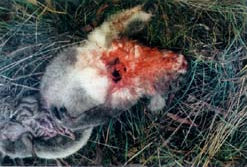 Strzelecki Koala Endangered
(South Gippsland Victorian, Australia) Strzelecki Koala Endangered
(South Gippsland Victorian, Australia)
.
<<Of major concern due to the logging and clearing activities of both Hancock Timber Resource Group and PaperlinX is the long term survival of populations of the Strzelecki and South Gippsland Koalas whose entire habitat is now owned by these companies.
An investigation carried out by Dr Bronwyn Houlden, School of Biological Science, University of New South Wales, 20th March 1997 and 6th April 1998 confirmed that the genetic pool of these koalas has not been compromised. Dr Houlden indicates that on a national basis koalas generally are not considered to be threatened. She advises that this assessment has unfortunately led to an extremely simplistic view of conservation of biodiversity in the species.
Through extensive analysis by herself and her collaborators she has revealed that the species is composed of highly differentiated populations with low levels of gene flow between populations throughout their range. The Strzelecki Koala population constitutes a separate management unit and is significant in terms of management of biodiversity on a regional and state basis. Dr Houlden found that the Strzelecki Ranges had the highest level of genetic variation, of any Victorian population she has analysed. This is important, given the low levels of genetic variability found in many populations in Victoria, which have been involved in the translocation program.>>
.
[Source: ‘Strzelecki Koala Endangered’, Hancock Watch (conservation group), ^http://hancockwatch.nfshost.com/docs/koala.htm#content_top]
.
.
The Critical Habitat Truth behind Hancock Timber Resource Group
.

Foreign-owned and controlled Hancock Timber Resource Group, claims publicly that its Victorian timber plantation operation, Hancock Victorian Plantations (HVP) is committed to…
“environmental responsibility is underpinned by the company’s environmental policy and management system, forest stewardship program, best management practices, which include internal and external performance measures, and active community consultation program, working with groups such as Landcare, field naturalists and Waterwatch.”
.
Hancock Victorian Plantations claims…
“HVP sets its own high standards, its operations are monitored by local shires, water catchment management authorities, the Environment Protection Authority (EPA) and the Victorian Department of Environment and Sustainability. The company is also subject to regular audits to maintain its Australian Forestry Standards (AFS) and Forest Stewardship Council (FSC) certifications.”Around 70 per cent of HVP’s total landholdings are sustainably-managed plantations, growing largely on land that was previously cleared for farming. The company maintains the remaining 30 per cent of its holdings for plantation protection, conservation and other community values.In the Strzelecki Ranges, HVP has set aside almost half of its land from timber production, managing this native forest for conservation.”
[Source: ^http://www.hvp.com.au/environment-conservation]
.
Editor: It all sounds wonderful coming from this United States industrial logger. But since when has anyone trusted US corporations? Read the snapshot log below.
.
 Road hit female koala with broken jaw. Had to be euthanised after 6 weeks.
Urgent research is required to determine breeding populations, location and numbers. Logging seriously impacts on long term populations of this animal.
[Source: Hancock Watch, ^http://hancockwatch.nfshost.com/docs/koala.htm#content_top] Road hit female koala with broken jaw. Had to be euthanised after 6 weeks.
Urgent research is required to determine breeding populations, location and numbers. Logging seriously impacts on long term populations of this animal.
[Source: Hancock Watch, ^http://hancockwatch.nfshost.com/docs/koala.htm#content_top]
.
.
Snapshot of a month’s logging of Koala Habitat:
[Source: ^http://hancockwatch.nfshost.com/docs/04sep.htm ]
.
South Gippsland, Victoria (October 2002) – systematically being destroyed for corporate profit by United States multi-national ‘Hancock Timber Resourse Group’:
.
Jeerlang West Road Strzelecki Ranges
- Locals outraged by removal of native vegetation – Koala Feed Trees. Koala corridor destroyed. Koalas are now not sited in this area. 8 Koalas have died in this area in the last 12 months.
.
Strzelecki Ranges (Jeeralangs)
- Eucalypts globulus – Bluegum (4ssp.) Southern Blue Gum – subspecies globulus. Restricted on the mainland to South Gippsland and Otways. Road works resulted in logging of older trees. Prime koala habitat destroyed by Grand Ridge Plantations/Hancock. A recent change in management will hopefully result in the end of this type of practice.
.
Strzelecki Ranges (Jeeralangs)
- Prime koala habitat destroyed without permit application by Grand Ridge Plantations/Hancock. Destruction of the rare Globulus globulus.
.
93-41 Creswick plantations
- Creek crossing over Anderson’s Gully which feeds into Creswick Creek. Tullaroop Water Catchment. Drinking water for Maryborough, Carisbrook, Talbot, Adelaide Lead, Alma, Havelock, Majorca and Betley. Sediment enters waterways mainly via creek crossings and roads.
.
93-41 Petticoat Plantation
- Tributary of Anderson’s Gully in the headwaters of the Murray Darling Catchment (Loddon River). Logging machinery driven straight through creekline.
.
93-41 Petticoat Creek
- Closeup of machinery entering tributary of Anderson’s Gully in the Tullaroop Water Catchment. Note build up of sediment which will wash into gully after rain. Note also buildup of stagnant water.
.
93-41. Petticoat Plantation
- Tullaroop Proclaimed Water Catchment. Machinery access into Anderson’s Gully tributary.
.
Morwell River East Branch/Strzelecki Ranges
- Creek crossing with sediment washing into waterway. Note also Slender Tree Fern an FFG listed species. Australia’s first FSC Assessment team in the Strzelecki Ranges. Discussing roading/landslide issues in the Jeerlangs.
.
Traralgon Creek in the Latrobe River catchment (Strzelecki Ranges)
- Recent pine logging with limited bufferzone in a pine plantation by Grand Ridge Plantations/Hancock. As part of the Friends of the Gippsland Bush/Australian Paper Agreement of 1997, 50 m buffers of native vegetation will be established along Traralgon Creek after pine logging. There were also problems with a creek crossing at this location, which can be seen eroding into the creek in this photo.
.
Tributary of Jeeralang Creek with cool temperate rainforest (Strzelecki Ranges)
- A Myrtle Beech tree is in the centre of the gully. The person in the photo is holding a twig with Myrtle Beech leaves taken from the base of a tree in the gully. According to the 1997 8 Point Agreement 50m buffers along Jeeralang Creek will be replanted with indigenous species. This area should not have been logged at all. Cool Temperate Rainforest needs much greater buffer for its long term protection and survival.
.
Jeeralang West Road
- (Non-plantation) Blackwood and Austral Mulberry cut down along roadside easement which is Crown Land. Logged by Grand Ridge Plantations/Hancock.
.
Billy’s Creek Catchment/Strzelecki Ranges
- Twenty metre buffer should be reinstated at this site as in accordance with Billy’s Creek Water Supply Catchment, Plan no 1870. (Ideally the entire slope should be retired from timber production due to its steepness).
.
Billy’s Creek catchment/Strzelecki Ranges
- 20m buffers should be reinstated in this plantation area.
.
Jumbuk Road/ Strzelecki Ranges
- Logging of roadside buffers/easements. Wildlife corridors destroyed at this site as well as the head of a gully feeding into Billy’s Creek.
.
93-29 Scarsdale Plantation (Woady Yaloak catchment)
- What is the long term impact on water yield from pine plantations in this catchment?
.
93-41 Petticoat plantation (Headwaters of the Murray Darling catchment [Loddon River])
- Tullaroop Water catchment is currently at 30% of its capacity due to primarily to drought. Hancock logged 223ha of pine in this catchment in 2001/2. Much of the land within the Creswick State Forest has in the past been affected by gold mining activities. Stabilisation of the worst affected areas was achieved with softwood plantations. Will sediment from these mining sites be disturbed by current plantation logging. Tullaroop catchment supplies towns such as Maryborough with drinking water. What is the impact of logging on water quality and quantity in this catchment?
.
Korweinguboora Reservoir catchment.
- Recently logged by Hancock. Note lack of buffer zones for this wetland feeding into the Reservoir. This reservoir supplies Geelong and other towns with drinking water.
.
Korweinguboora catchment (Geelong’s water supply)
- How can Hancock guarantee that herbicides and fertilser residues will not enter Geelongs water supply? Note lack of buffers surrounding this drainage line.
.
A tributary of Creswick Creek in the Tullaroop Water supply catchment
- Note lack of creek buffer zones and ripping of soil into creek banks. Will herbicide residues enter water from this site? What impact will operations at this site have on quality of water for all species including people? Is this sustainable?
.
Tributary of Creswick Creek in Tullaroop water supply catchment
- Over 200 ha of pine plantations in this catchment were logged in 2001/2. What is the long term effect of fast rotation plantations on water quality and quantity? Pines cut out of creek itself and creek banks at this site.>>
.
.
Bligh Labor Government flogs off Queensland’s forests for $603M to Hancock
.
[Source: ‘State sells off Forestry Plantations Queensland for $603 million to Hancock Queensland Plantations’, AAP, 20100518, ^ http://www.couriermail.com.au/business/state-sells-off-forestry-plantations-queensland-for-603-million-to-hancock-queensland-plantations/story-e6freqmx-1225868108050]
.
.
<<The Queensland Labor government has announced the sale of Forestry Plantations Queensland – the first transaction in its controversial asset sales. Treasurer Andrew Fraser said the 99-year licence for the timber plantation business would be sold for $603 million to Hancock Queensland Plantations. The sale price is well in excess of the $500 million that had been anticipated. Mr Fraser said he signed the contract on Tuesday morning.
“By reaching agreement on a price of $603 million, this exceeds original expectations and is great news for Queensland taxpayers,’‘ Mr Fraser told state parliament on Tuesday. “This is the first of the five commercial businesses to be sold, licensed or leased to the private sector, as the government reforms the state balance sheet and builds a stronger Queensland economy.”
He said award staff would have their jobs guaranteed for three years. Mr Fraser said Hancock Queensland Plantations, a company managed by Hancock Timber Resource Group on behalf of institutional investors, had won the right to grow and harvest the trees.
Crown plantation land on which the majority of the business sits will remain in government ownership. The sale includes about 35,000 hectares of freehold land, which is about 10 per cent of the total estate.
Hancock Timber Resource Group manages more than two million hectares of timberlands worth approximately $US8.5 billion ($A9.7 billion) across the United States, Brazil, Canada, New Zealand and Australia.>>
.
.
NSW Government accused of logging Koala Habitat
[Source: ‘NSW govt accused on koala habitat logging’, 20111118, ^http://news.ninemsn.com.au/national/8375719/nsw-govt-accused-on-koala-habitat-logging]
.
<<The opposition has accused NSW Environment Minister Robyn Parker of allowing the logging of koala habitats on the state’s mid-north coast. Opposition environment spokesman Luke Foley said the minister had received a “scathing” letter from the local councils protesting her decision to allow logging of core koala habitats in the area.
“These councils are traditionally pro-development – but even they are alarmed that Robyn Parker is allowing a national icon to be endangered thanks to her ‘unsound ecological approach’,” Mr Foley said in a statement on Thursday.>>
He said that…
On October 27 Ms Parker said “logging protects koalas”
.
Editor: Robyn Parker has not got a clue about her Environment portfolio. She is another teacher-turned-politician and clearly insecure. Last month Parker sacked the head of her department, Lisa Corbyn, and has been through five press secretaries.
The opposition’s environment spokesman Luke Foley: “When will Premier O’Farrell do the decent thing and get a new environment minister?”
[Source: ‘Controversial Environment Minister Robyn Parker creates a climate of change’, by Andrew Clennell, State Political Editor, The Daily Telegraph, 20120121, ^http://www.dailytelegraph.com.au/news/minister-creates-a-climate-of-change/story-e6freuy9-1226249892102]
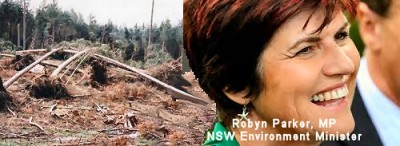 Embattled: Ms Parker – thinks she’s only accountable to herself and Premier O’Farrell.
Picture: Kristi Miller Source: The Daily Telegraph Embattled: Ms Parker – thinks she’s only accountable to herself and Premier O’Farrell.
Picture: Kristi Miller Source: The Daily Telegraph
.
.
New South Wales allowed logging in Koala Habitat
.
[Source: ‘NSW allowed logging on koala habitat’, by Rosslyn Beeby, Science and Environment Reporter, Canberra Times, 20110210, ^http://www.canberratimes.com.au/news/national/national/general/nsw-allowed-logging-on-koala-habitat/2072043.aspx]
.
<<The NSW Government has allowed 2,000 heactares of koala habitat to be logged at Coffs Harbour in northern NSW, despite a local koala conservation plan endorsed by the local council, a Senate inquiry has heard.
One of Australia’s leading koala researchers, Alistair Melzer, has accused federal environment bureaucrats of doing little to avoid ”an escalating conservation crisis” as koala populations decline.
Dr Melzer, who heads Central Queensland University’s koala research centre, told the Senate environment committee inquiry it appeared that Canberra’s bureaucrats ”do not seem to be sensitive to the real state of the environment”.
The six-month inquiry, into the conservation status and sustainability of Australia’s koalas, is investigating threats to the future survival of the species.
In his submission, former Coffs Harbour City Council deputy mayor Rod McKelvey said the NSW Department of Environment’s private native forestry division granted logging permits which resulted in the loss of 2000ha of ”core koala habitat” protected by the council’s koala conservation plan. Mr McKelvey said the department subsequently argued the plan ”did not fall under” NSW environmental planning policy.
”I do not want to be included in the generation who stood by and did nothing while we systematically destroyed koala habitat, making it almost impossible for them to live here,” he said.
Gunnedah farmer Susan Lyle, who has koalas on her three properties, raised concerns about a mining exploration licence issued for open-cut coal mining in the region.
”Our koalas will be decimated. This mining licence is primarily in isolation and to allow such a development is sheer lunacy … There are many, many other resources that can be used for energy, but there is no replacement for the koala,” she said.
.
.
Federal Forest Enquiry a Sham
.
[Source: ‘Federal Forest Inquiry a Sham’, 20111130, North East Forest Alliance, ^http://nefa.org.au/]
.
<<Conservation Group, North East Forest Alliance (NEFA), is outraged at the bias of the Federal House of Representatives report ‘Inquiry into the future of the Australian Forestry Industry’ and its refusal to consider the timber supply crisis and the over-logging of north-east NSW’s public forests.
NEFA spokesperson, Dailan Pugh, said that most of the evidence presented in NEFA’s 111 page submission was ignored by the inquiry on the grounds that it “criticised the industry”. “What they didn’t ignore they misrepresented. This pretend inquiry was a sham” he said.
“The Commonwealth is party to the North East Regional Forest Agreement (RFA) and claims that it satisfies its national and international obligations for the protection of world heritage, national estate and threatened species.
“While national heritage values were meant to be addressed as part of the RFA, they were not, so the Commonwealth gave the NSW Government an extra two years to complete the process. A decade later and there has still been no assessment and the Federal Government does not care.
“Similarly the RFA was meant to provide protection for nationally threatened species. The evidence we presented, such as the illegal trashing of a population of the nationally endangered fern Lindsaea incisa at Doubleduke, that was meant to be protected by a 50m buffer, was ignored because we were being ‘critical’.
“What is most astounding is that the inquiry refused to consider the evidence we presented on the current timber supply crisis due to the over-commitment of wood from north-east NSW’s public forests.
“Ever since new Wood Supply Agreements for timber from public land were given to sawmillers in 2004 Forests NSW have not been able to supply the committed volumes,” Mr Pugh said.
“The NSW Government’s recklessness in issuing these new Wood Supply Agreements has already cost taxpayers millions of dollars to buy back committed volumes and to compensate BORAL for Forests NSW’s failure to supply. As the crisis worsens, taxpayers exposure to multi-million dollar compensation claims grows.
“In vain efforts to meet shortfalls and reduce their payouts Forests NSW have been over-logging plantations, cutting trees before they mature, increasing logging intensities, logging stream buffers, and logging trees and areas required to be retained for threatened species. They are cutting out the future of the industry and causing immense environmental harm in the process.
“It is appalling, that an inquiry dealing with forestry has completely ignored this crisis and recommended that the Commonwealth Government condone and support this grossly unsustainable and irresponsible logging.
“Local Page MP, Janelle Saffin features in the inquiry’s report despite her electorate being one of the worst affected by the timber supply crisis, rampant illegal logging and widespread forest dieback.
“We call upon Janelle to please explain why the Commonwealth continues to ignore the gross over-logging, fails to identify and protect national heritage values, refuses to take action on the illegal logging of the habitat of nationally threatened species and refuses to consider the dieback of tens of thousands of hectares of public forests in her electorate. She needs to tell her constituents what she is going to do about it”” Mr. Pugh said.>>
.
.
South East Forest Rescue cranking it in south-east NSW
.
[Source: ‘South East Forest Rescue cranking it in south-east NSW’, 20120118, ^http://www.thelaststand.org.au/tag/southeast-forest-rescue/]
.
<<South East Forest Rescue have taken some crackerjack action this morning, halting forestry operations with a giant tripod and tree sit structure to highlight illegal logging in the Yambulla State Forest, south of Eden. The logging compartment where breaches have been identified by SEFR contains records of nationally listed endangered species such as glossy black cockatoos, smokey mice, southern brown bandicoots, tiger quolls, eastern pygmy possums, bent wing bats, yellow-bellied gliders, gang gang cockatoos and white-footed dunnarts.
“The response from Forests NSW shows the complete lack of regard for the licence conditions that Forests NSW and their contractors must abide by. The licence conditions for threatened species and habitat conservation are not being adhered to, even though the conditions are grossly inadequate” said forest campaigner Lisa Stone.
“We have reported the breaches in this compartment to the Office of Environment and Heritage,” said Ms Stone. “We stated last time that the probability of further breaches in this compartment if harvesting continues is high given that this logging contractor is a repeat offender and that FNSW still is not complying with the licence conditions” said Ms Stone.>>
.
.
‘NSW failing to protect koalas: Labor’
.
[Source: ‘NSW failing to protect koalas: Labor’, 20111027, AAP republished in the Sydney Morning Herald, ^http://www.smh.com.au/environment/conservation/nsw-failing-to-protect-koalas-labor-20111027-1mlnt.html]
.
<<The NSW Liberal government is failing to protect koalas by allowing logging in remaining habitats, the opposition says. Environment spokesman Luke Foley accused Environment Minister Robyn Parker of breaking an election promise to protect koalas after logging went ahead at the Bermagui State Forest on the south coast.
Logging also started last week at Boambee State Forest on the mid north coast, one of the last habitats for the vulnerable species in the area, Mr Foley said.
“For you to fail to respond and fail to intervene is a gross breach of your election policy to protect our national icon,” Mr Foley said at a budget estimates hearing in Sydney today. “Surely the precautionary approach would be for you as Environment Minister to stop the logging of this key koala habitat?”
Ms Parker denied breaking any election commitments, and said the government was working hard to protect koalas.
“When it comes to forestry, we are about getting a balance and protecting our native species. We are working very hard on them,” she said. “We have written to Forests NSW recommending a precautionary approach to managing impacts on koalas in the Boambee State Forest…The agreement that allowed logging to take place had been signed by the previous government, Ms Parker said. “Perhaps you should go back and look at what was going on when your government signed up to that agreement.”>>
.
.
Koala habitat cleared to make way for more houses
.
[Source: ‘Koala habitat cleared to make way for more houses’, 20121127 (today), by Nicole Fuge, Sunshine Coast Daily, ^http://www.sunshinecoastdaily.com.au/news/koalas-lose-vital-coast-habitat/1637085/]
.
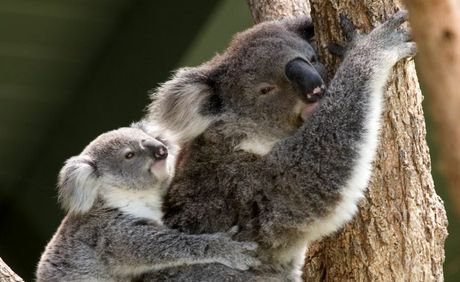
<<More than 100 hectares of koala habitat has been cleared to make way for more houses, another nail in the coffin for one of Australia’s icons.
Work has begun clearing the land behind Aussie World and the Ettamogah Pub for a 334-lot rural residential development.
Despite more than 30% of the 145-hectare site secured for environmental reserve and 12 hectares of revegetation to offset present clearing, Sunshine Coast Koala Wildlife Rescue volunteer Ray Chambers fears it’s not enough.
Mr Chambers said the area’s koala population was already fragile and the removal of so many trees would have a disastrous affect.
“We do have the odd koala in part of the Palmview area, it’s not a great deal but we know they are there,” he said. “From Forest Glen to the Caloundra turn-off is a koala corridor.”
.
Mr Chambers said there were only about 100 koalas left on the Coast, representing 18% of the Queensland population.
.
A council spokeswoman said despite approval of the development pre-dating an introduction of state-wide regulatory provisions for koala conservation, the council and Department of Environment and Heritage Protection officers had enforced koala protection measures and vegetation offsets.
Developer guidelines include:
- More than 30% of the original site secured in environmental reserve.
- Traffic calming, speed bumps, and fauna under and overpasses installed to minimise car strikes.
- Building envelopes to be enclosed with dog-proof fencing, leaving the balance of each lot free for fauna movement.
- About 12ha of revegetation, including planting koala food trees, to be carried out to offset the clearing.
The spokeswoman said a fauna spotting catcher had also been present during clearing.>>
..
Ed: What chance do Koalas have?
.
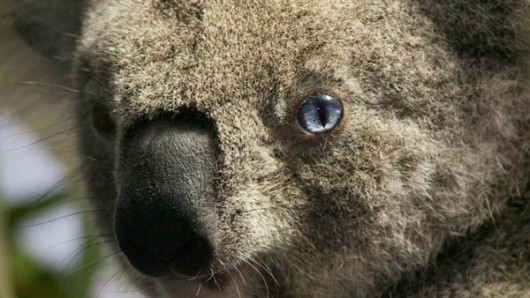 [Source: National Geographic, ^http://natgeotv.com.au/tv/koala-hospital/gallery.aspx] [Source: National Geographic, ^http://natgeotv.com.au/tv/koala-hospital/gallery.aspx]
.
Tags: Australia, Forests NSW, Government Loggers, Koala, koala extinction, koala habitat, New South Wales, NSW Forest Agreements, South East Forest Rescue
Posted in Gippsland (AU), Koalas, South East Corner (AU), Threats from Deforestation | 2 Comments »
Add this post to Del.icio.us - Digg
Sunday, September 2nd, 2012
[The following article was written by Tigerquoll and initially published under the title ‘Anthology of State Serial Rape of Bermagui’s Spotted Gum Forest Habitat‘, on ^CanDoBetter.net 20100216]
 Click this image to play music
then click back to this article as it plays Click this image to play music
then click back to this article as it plays
.
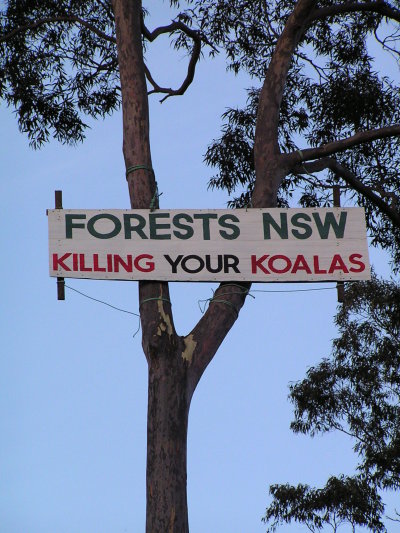 Nothing less than the Australian Government can be trusted to protect vital Koala Habitat.
Lesser smaller-minded state governments only see Koala Habitat as a logging and tourism resource.
Small minded politicians like Kristina Keneally can never be trusted with national treasures
Nothing less than the Australian Government can be trusted to protect vital Koala Habitat.
Lesser smaller-minded state governments only see Koala Habitat as a logging and tourism resource.
Small minded politicians like Kristina Keneally can never be trusted with national treasures
.
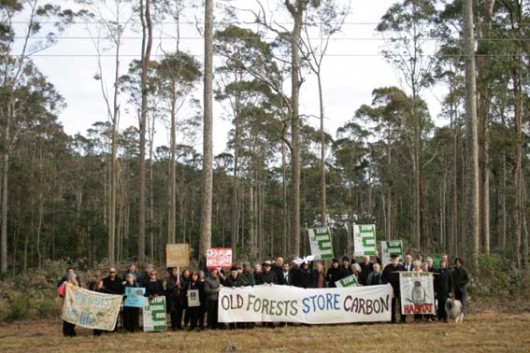 Bermagui’s Spotted Gums
..the local Narooma Community in their defence against ‘Forest NSW’ (the Forest-Fiddling loggers)
Bermagui’s Spotted Gums
..the local Narooma Community in their defence against ‘Forest NSW’ (the Forest-Fiddling loggers)
.
 Forest-Fiddling Logger driving his Spotted Gum spoils truck
Forest-Fiddling Logger driving his Spotted Gum spoils truck
.
 But Eucalyptus maculata is a tree, not a floor But Eucalyptus maculata is a tree, not a floor
.
In terms of Australia’s iconic ‘Spotted Gum’, the word “spotted” refers to the soft mottled colour caused by weathering of the outer tree as it sheds elliptical strips of bark.
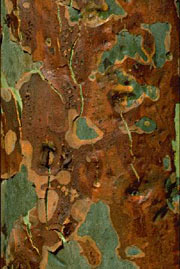 Spotted Gum bark Spotted Gum bark
.
This colour varies from pale greybrowns and soft creams to a rich chocolate brown. A very tough timber, its frequent wavy grain can produce an attractive and highly valued fiddleback effect. [Source: Boral website, ^http://www.boral.com.au/timberflooring/timber_species_-_spotted_gum.asp]
.
 Build something great, but don’t destroy something great in the process
– like Koala Spotted Gum Forests!
Invest in Boral and you invest in Koala extinction
Build something great, but don’t destroy something great in the process
– like Koala Spotted Gum Forests!
Invest in Boral and you invest in Koala extinction
.
About 380km south of Sydney lies what NSW Tourism labels the beautiful ‘Sapphire Coast’ with the popular seaside town of Bermagui.
Less than 3km north of Bermagui heading north along Bermagui-Cobargo Road and up the Bermagui River estuary is the Bermagui State Forest – a label by the NSW Department of Primary Industry (DPI) given to magnificent Spotted Gum forest.
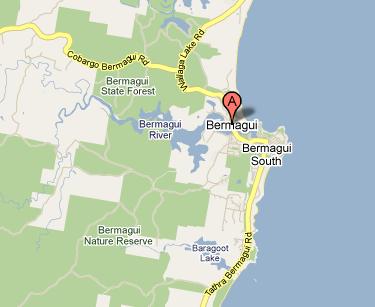 . .
This forest is vital habitat for threatened native fauna – the Yellow Bellied Gliders, Grey-Headed Flying Foxes, Tiger Quolls, Sooty Owls, Sea Eagles, Possums and Australia’s iconic Koala.
.
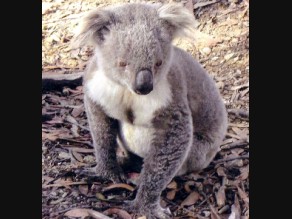 Koala in Bermagui’s Spotted Gum forest – a displaced landlord
Koala in Bermagui’s Spotted Gum forest – a displaced landlord
.
Australia’s iconic ‘Spotted Gums’
.
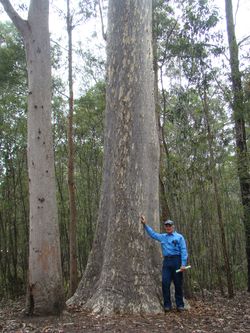 A mature iconic Spotted Gum Tree
About 400 years old, about 30 metres high
A mature iconic Spotted Gum Tree
About 400 years old, about 30 metres high
[Source: ‘A gum tree that saw Captain Cook and before’, ABC Radion interview of John Knight by Ian Campbell, 20100119,
Listen to Interview: ^http://blogs.abc.net.au/nsw/2010/01/a-gum-tree-that-saw-captain-cook-and-before.html]
.
Australia’s magnificent and unique Spotted Gums are naturally distributed in open forests along the hilly coastal corridor from south-east Queensland down through New South Wales and with a few isolated pockets in East Gippsland, Victoria. They belong to the botanical family ‘Myrtaceae’ and grow straight and tall up to 40 metres. Their height attracts roosting by Sea Eagles.
 Note the planet’s sole natural distribution of Spotted Gum Forests
They have become the target of corporate development simply because Spotted Gums prefer a mild temperate climate near the coast
..like Australia’s millions of breeding humans, and profiteering corporate developers
Note the planet’s sole natural distribution of Spotted Gum Forests
They have become the target of corporate development simply because Spotted Gums prefer a mild temperate climate near the coast
..like Australia’s millions of breeding humans, and profiteering corporate developers
.
Spotted gums flower once every two years and produce a rich pollen that attracts native birds such as Lorikeets and Yellow Tailed Cockatoos as wells as possums and flying foxes including the IUCN vulnerable listed Grey-Headed Flying Fox. [Source: Australian Native Plants Society, Corymbia maculata, ^http://asgap.org.au/c-mac.html]
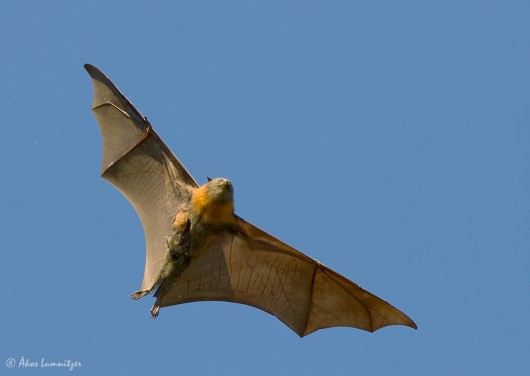 Grey-Headed Flying Fox (Pteropus poliocephalus)
The grey-headed flying-fox is listed as vulnerable to extinction under NSW and Australian legislation because of declining numbers and key threats such as habitat loss and urban conflict. Records indicate that grey-headed flying-foxes may once have numbered in the millions, but are now reduced to as few as 400,000. In the decade before listing, their population was estimated to have declined by 30%.
(Photo by Ákos Lumnitzer, ^http://amatteroflight.com/) Grey-Headed Flying Fox (Pteropus poliocephalus)
The grey-headed flying-fox is listed as vulnerable to extinction under NSW and Australian legislation because of declining numbers and key threats such as habitat loss and urban conflict. Records indicate that grey-headed flying-foxes may once have numbered in the millions, but are now reduced to as few as 400,000. In the decade before listing, their population was estimated to have declined by 30%.
(Photo by Ákos Lumnitzer, ^http://amatteroflight.com/)
.
Unlike the declaration of a ‘National Park’ which affords federal environmental protection to forest habitat, the State label of a ‘State Forest’ is a misnomer. A ‘State Forest’ is deemed a timber and woodchip resource for logging. The same public relations label is used across New South Wales, ACT, Victoria, Western Australia, Tasmania and Queensland. A State Forest is not treated as a forest for its natural habitat values, but rather as a logging coup on death row, that can be chainsawed at will anytime. Perhaps ‘Death Row Forest’ is a more apt label than speaking the State euphemism of ‘State Forests’.
And its public relations label logging as ‘harvesting’, a euphemism to belie the destructive reality.
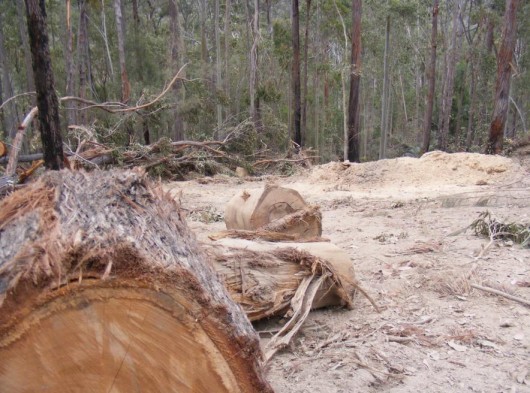 Bermagui State Forest after the loggers Bermagui State Forest after the loggers
.
The NSW Logging Offensive of 1988
.
On the back of a century of clear felling Bermagui State Forest was logged in the late 1980s. Then according to data from the ‘Bureau of Resource Science‘ (aka science graduates on the payroll of loggers), 148ha were “thinned” in 1996, and another 133ha that same year, then 94ha in 1999.
Typically 70% of the spotted gums goes to Boral’s mills in Narooma, Nowra and Batemans Bay as sawlogs to be processed into mainly flooring. The remainder end up as woodchips at Nippon Paper’s woodchip mill at Twofold Bay for export to Japan.
So Australia’s precious endangered habitat is being destroyed for house flooring and office paper. .
.
The NSW Logging Offensive of 2008
.
In October 2008, NSW Forests logged what it labeled “two compartments” in Bermagui State Forest north of Bermagui. It justified this under the infamous Eden Regional Forest Agreement (RFA). [>Read Agreement] [Source: ^http://www.daff.gov.au/__data/assets/pdf_file/0009/51021/nsw_rfa_eden.pdf]
This RFA is one of three established in 1999, in which the NSW Government relegated 15.1 million hectares of native forests across New South Wales for logging anytime. The usual public relations spin preceded the logging. Southern Region manager of Forests NSW, Ian Barnes.
It was at this time that Labor’s Minister for Primary Industries (Forests NSW) Ian MacDonald and Labor’s Minister for Police Tony Kelly started to use Dick Cheney tactics to push their weight around with protesters. The following questions to the NSW Legislative Council by NSW Greens Senator Lee Rhiannon on 28th October 2008, highlight the escalated use of law enforcement into a heavy handed riot squad:
.
Lee Rhiannon MLC:
“I direct my question to the Minister for Police. Did officers stationed at Batemans Bay police station in collaboration with Forests New South Wales hold a meeting at the Bermagui Country Club in September to warn locals associated with calling for forest protection not to protest when logging commenced in the Bermagui State Forest? Does the holding of this meeting reflect that Batemans Bay police officers have adopted a zero tolerance policing approach to forest protesters? Considering that since logging started in Bermagui State Forest on 27 October with a group of about 40 protesters gathered in the vicinity, about 15 police cars, more than 20 police, including members of the Public Order and Riot Squad, a mobile police command bus and two police rescue vans have been in attendance, will this level of policing continue for the coming six weeks of logging in this area? What is the anticipated cost of this operation?
.
Tony Kelly MLC (response):
“The Far South Coast Local Area Command of the New South Wales Police Force has been advised that New South Wales Forests is to commence logging compartments of Bermagui State Forest later this month. As in the past, protests are expected. As always, the New South Wales Police Force is committed to maintaining public order. For this reason, local police and various commands, including the Public Order and Riot Squad, Highway Patrol and Rescue Squad will join together to conduct an operation.
This operation will focus on ensuring the protection of persons engaged in lawful activities. Local police have made it clear that anyone engaging in unlawful or dangerous activity in or near the logging operation will have action taken against them. When offences continue and are considered dangerous, police will arrest and charge people as necessary. Police respect people’s rights to protest during these times; in no way are they looking to prevent lawful and peaceful protests. Police have asked anyone who intends to protest to contact them so that they can attempt to facilitate lawful activity, minimise disruption and focus on protecting the safety of everyone involved.”
.
[SOURCE: ‘Bermagui State Forest Logging Protests‘, Question raised NSW Legislative Council by The Greens Senator Lee Rhiannon, Parliament of New South Wales, Hansard, 20081028, ^http://www.parliament.nsw.gov.au/prod/parlment/hanstrans.nsf/V3ByKey/LC, 20081028, >Read Hansard Extract – go to page 10631, PDF, 344kb ]
.
The NSW Logging Offensive of Feb 2009
.
On Monday 2nd February 2009, logging operations resumed in the Bermagui State Forest after the summer holiday break period and continued for about two months.
Bruce Mathie and Sons is one of the prominent loggers in the area, but most timber finds its way either as saw logs to Boral for Spotted Gum flooring or else to Nippon Papers woodchip mill at Twofold Bay, Eden for export to Japan.
The forest eco-rapers ‘Forests NSW’ – bulldozed, chainsawed, logged, then left with their booty.
.
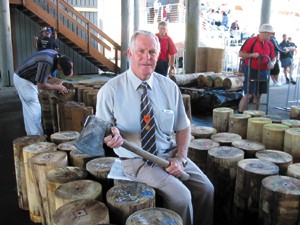 Kevin Mathie – 4th generation logger Kevin Mathie – 4th generation logger
.
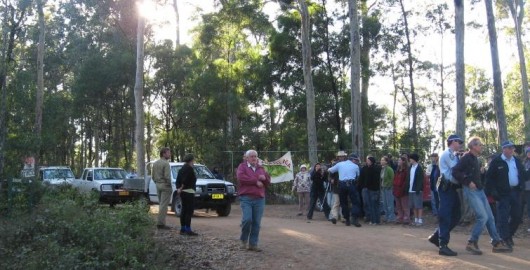 Logging contractor, Gil Mathie, in the middle of the picture at front (pink jumper)
More notably, this editor is saddened by bearing witness to a senior member
of the Bermagui community being arrested for conserving Spotted Gums and Koalas.
We love, we defend, we act for love.
Salute the man being arrested.
[Source: Local environmentalist, John Perkins, Gulaga Protest near Tilba on the NSW South Coast, 20070514]
Logging contractor, Gil Mathie, in the middle of the picture at front (pink jumper)
More notably, this editor is saddened by bearing witness to a senior member
of the Bermagui community being arrested for conserving Spotted Gums and Koalas.
We love, we defend, we act for love.
Salute the man being arrested.
[Source: Local environmentalist, John Perkins, Gulaga Protest near Tilba on the NSW South Coast, 20070514]
.
Labor’s Ian MacDonald’s Forestry Regulation of 2009
.
But rather that do the right thing by the Environment and by the Community and obey the law of the land, those in power The Labor Government’s (Forests NSW) forced changes to the law of the land to bloody well suit themselves. Arguably reminiscent of England’s King Henry VIII changing laws to accommodate his adultery, or Joh Bjelke-Petersen’s gerrymandering that secured his electoral hold on power.
In order to keep the cameras and local conservationist away from the loggers destructive practices, Forests NSW got the Minister to legislate an exclusion area around its logging with the public relations labeling of “mainly for safety reasons”.
On 1 September 2009, the NSW Forestry Regulation 2009 came into force making it illegal for anyone to trespass into areas marked by NSW Forests for logging. This has given Forests NSW absolute logging power with the police as its enforcement lackies.
Forests NSW Minister for Primary Industries, Ian MacDonald, tabled the Bill and it became law preventing democratic protests by people trying to save important habitat from destruction. It has given loggers free reign to log State Forests with impunity.
Under Part 3, Division 1, Clause 11 of this Regulation, a logger has legal authority to request anyone to leave a forestry area and this includes if that person “causes inconvenience.”
Under Clause 12, a logger can forcible remove anyone from a forestry area “who is causing annoyance or inconvenience.”
Surely such removal by a logger can be construed an assault under the Crimes Act? It is draconian. It is certainly an assault on Australians’ democratic right to protest. What was Ian MacDonald thinking?
.
Labor’s Ministers in charge three years hence…
.
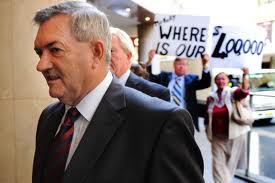 Labor’s Police Minister Tony Kelly MLC
NSW Minister for Emergency Services, Lands, Police and Primary Industries.
Labor’s Police Minister Tony Kelly MLC
NSW Minister for Emergency Services, Lands, Police and Primary Industries.
.
‘Tony Kelly was targeted by protesters as he arrived to give evidence at the ICAC in June. Today the commission has found the former minister engaged in corrupt conduct.’
[Source: Protesters target Kelly outside ICAC’, by Dean Lewins, AAP, 20111212, ^http://www.abc.net.au/news/2011-12-12/protesters-target-kelly-outside-icac/3725744]
.
‘DISGRACED former state Labor ministers Tony Kelly and Ian Macdonald are demanding taxpayers foot their legal bills and the state government could be forced to hand over up to $250,000. Despite being found by corruption watchdog ICAC to have forged official documents while a minister, Mr Kelly has formally asked the O’Farrell government to cover the cost of his elite legal team.’
[Source: ‘Disgraced former Labor ministers Tony Kelly and Ian Macdonald demand taxpayers foot their bills’, by Barclay Crawford, Daily Telegraph, 20120101, ^http://www.dailytelegraph.com.au/news/disgraced-former-labor-ministers-tony-kelly-and-ian-macdonald-demand-taxpayers-foot-their-bills/story-e6freuy9-1226234077573].
.
 Labor’s Logging Minister Ian MacDonald MLC
Forests NSW/ Minister for Primary Industries in 2009 Labor’s Logging Minister Ian MacDonald MLC
Forests NSW/ Minister for Primary Industries in 2009
.
‘The disgraced former NSW resources minister Ian Macdonald is to face a new corruption inquiry into the granting of coal exploration licences. The Independent Commission Against Corruption said in a statement yesterday that Mr Macdonald is being investigated for allegedly using his ministerial position ”to advantage the private interests of others”.
[Source: ‘ICAC to examine mining licences‘, by Kate McClymont, Senior Reporter, Sydney Morning Herald, 20120524, ^http://www.smh.com.au/nsw/icac-to-examine-mining-licences-20120523-1z5ov.html‘]
.
‘The senior state minister Ian Macdonald signed taxpayers up to the V8 Supercars race without a system to manage potential conflicts of interest, without advice from the government’s major events body and without a proper business case, the NSW Auditor-General finds.’
[Source: ‘Mate’s race: $45m deal snares MP‘, by Anne Davies, Linton Besser and Nick O’Malley, 20100529, ^http://www.smh.com.au/nsw/mates-race-45m-deal-snares-mp-20100528-wldb.html]
.
The NSW Logging Offensive of Sep 2009
.
In September 2009, Forests NSW commenced logging again in Bermagui State Forest, like pack rapists marauding through a maternity ward.
Sure enough, on Monday, 14th September 2009, Police arrested two of four forest campaigners who had allegedly entered Bermagui State Forest in what Forests NSW had labeled logging compartments 2001 and 2002. Apparenpe known to support koalas is unacceptable, particularly when the NSW government cannot prove their claims that koalas can be found anywhere in the south east,” said Robert Bertram, local Friends of Five Forests member.
“This is yet another example of Forests NSW lack of care for community and the environment,” said Lisa Stone, spokesperson for South East Forest Rescue.
“They are logging old-growth in Dampier, threatened species habitat in South Brooman, endangered species habitat in Nadgee and now this.”
“The loss of biodiversity coupled with logging and burning means the condition of many forests is as bad as the endangered ecological communities on private land, unable to support most threatened and endangered species and unable to recover.”
“We urge the newly appointed Minister for the Environment, Mr John Robertson, to step in on behalf of the native forests and their dependents and stop these archaic practices.”
“The current government policy of destroying habitat to satisfy ‘wood supply agreements’ is robbing from the future generations their chance of survival. The amount of breaches was astounding and shows that Forests NSW cannot be trusted to log these important areas of Koala habitat.”
“We have inspected many other logging operations in the past year and have found the same breaches everywhere we have looked. This is pe known to support koalas is unacceptable, particularly when the NSW government cannot prove their claims that koalas can be found anywhere in the south east,” said Robert Bertram, local Friends of Five Forests member.
“This is yet another example of Forests NSW lack of care for community and the environment,” said Lisa Stone, spokesperson for South East Forest Rescue.
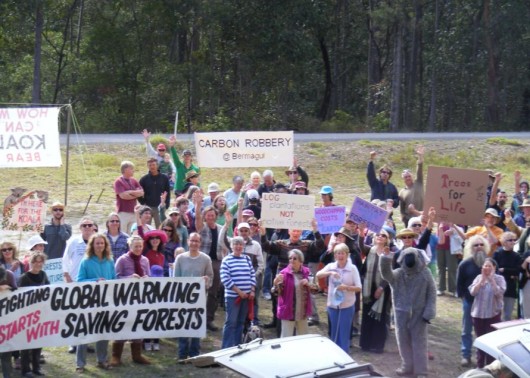 A community morally right to defend habitat and prepared to defend that right A community morally right to defend habitat and prepared to defend that right
.
“They are logging old-growth in Dampier, threatened species habitat in South Brooman, endangered species habitat in Nadgee and now this.”
“The loss of biodiversity coupled with logging and burning means the condition of many forests is as bad as the endangered ecological communities on private land, unable to support most threatened and endangered species and unable to recover.”
“We urge the newly appointed Minister for the Environment, Mr John Robertson, to step in on behalf of the native forests and their dependents and stop these archaic practices.”
“The current government policy of destroying habitat to satisfy ‘wood supply agreements’ is robbing from the future generations their chance of survival. The amount of breaches was astounding and shows that Forests NSW cannot be trusted to log these important areas of Koala habitat.”
“We have inspected many other logging operations in the past year and have found the same breaches everywhere we have looked. This is not a once off mistake but a systemic disgust for any environmental protection measures.”
Conservationists state the native forest logging industry is unsustainable and only propped up by political will, public subsidies and union backing.
Spokesperson for the South East Region Conservation Alliance, Pru Acton, says:
“The significant social and economic costs of reduced biodiversity can only increase while our natural systems are poorly managed.”
“Credible experts agree that the cost of logging this habitat is not only the last few koalas, but also potable water supplies, oysters, the inspiration for the local artists community, and another chunk of the Wilderness Coast’s tourism potential.”
“It seems the NSW Government has now decided its contractual obligations to supply sawlogs locally and woodchips to Asia is more important then protecting this much loved native animal.”
.
South East Region Conservation Alliance
.
Conservationists state the native forest logging industry is unsustainable and only propped up by political will, public subsidies and union backing.
Spokesperson for the South East Region Conservation Alliance, Pru Acton, says: “The significant social and economic costs of reduced biodiversity can only increase while our natural systems are poorly managed.”
“Credible experts agree that the cost of logging this habitat is not only the last few koalas, but also potable water supplies, oysters, the inspiration for the local artists community, and another chunk of the Wilderness Coast’s tourism potential.”
“It seems the NSW Government has now decided its contractual obligations to supply sawlogs locally and woodchips to Asia is more important then protecting this much loved native animal.”
.
[Source: ‘Logging resumes at Bermagui’, by Stan Gorton Narooma News, 20090204 – note the Narooma News has removed this news item online. However, the Narooma News has chosen not to remove its following story (Source: ^http://www.naroomanewsonline.com.au/story/191381/albino-possum-causes-log-truck-roll-over-at-narooma/ if it be not similarly removed].
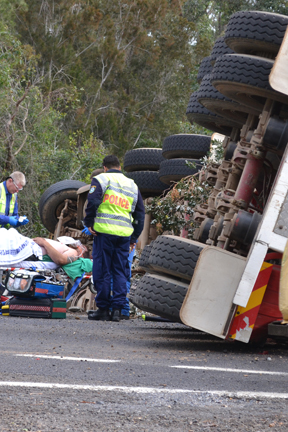 Speeding logging trucker blames possum
..Narooma News editor’s reputation shot Speeding logging trucker blames possum
..Narooma News editor’s reputation shot
.
Narooma News spins the following story to appease local logger readership:
.
“In a bizarre set of circumstances, a rare but dead albino possum is believed to have caused a log truck roll-over on the Princes Highway just south of Narooma.
The accident occurred just after 1pm when witnesses said a local from Wallaga Lake stopped to look at the road-kill possum that had been lying on the roadside at the entrance to the Island View Beach Resort.
A series of cars backed up behind the stopped vehicle in the southbound lane. Another Narooma local who was last in the line of stopped cars looked in his rear-vision mirror only to see the huge red-coloured truck coming up fast from behind.
“I think I am going to buy a lottery ticket,” said the local, who at one point thought the truck was going to smash into him and end his life.
The truck driver then allegedly swerved onto the wrong side of the road, narrowly missing the line of cars and while he was fortunate not to face any oncoming northbound traffic, he did lose control on the straight stretch of highway.
The truck reportedly clipped a boat trailer, flipped onto its side, sliding down the highway with the prime mover coming to rest in bushland just off the verge north of the Nangudga Bridge.
An ACT couple who among those first on the scene were able to help the truck driver out of the cab but they said he was badly shaken up and was not aware of where he was.
The Pambula man was the only person injured in the accident and was taken to Moruya Hospital for treatment.
The highway was closed down to one lane with firefighters, police and RMS personnel cleaned up and investigated the scene.
Residents from the nearby Island View caravan park were alerted to the accident by a loud bang and they lined the highway watching the accident.
The accident occurred at the start of the June long weekend where NSW police were out in force urging drivers to be careful on the busy roads.
Albino or golden brush-tailed possums are very rare but there is a known population living in the Narooma area.’
.
~ by the Narooma News editor…and watch out for drop bears too!
.
Meanwhile NSW Forests remains culturally contemptuous to NSW forests
.
Forests NSW recruit their students with Communications degrees to lie for it on its website:
“State forests in NSW are managed sustainably to provide a supply of timber today and into the future, to protect the environmental values of the forest and provide community amenities.”
Forests NSW website claims that “Ecologically sustainable forest management (ESFM) is our guiding philosophy. ESFM is about managing forests to maintain ecological principles and biodiversity while optimising the benefits to the community from all uses of the forest…”
 Narooma Community in defence of Koala Habitat
– clearly not convinced about Forests NSW spiel about “optimising the benefits to the community” Narooma Community in defence of Koala Habitat
– clearly not convinced about Forests NSW spiel about “optimising the benefits to the community”
.
Revolving Door politics of NSW Labor
.
In the revolving door politics of NSW Labor, Premier #3 Nathan Rees on 16th November 2009 sacked Ian MacDonald from his DPI Ministry.
Rees was himself sacked as premier on 3 December, then a week later, Labor Premier #4 Kristina Keneally (Labor show pony) reappointed Ian MacDonald ‘Minister for State & Regional Development and Minister for Mineral & Forest Resources‘ in December 2009.
The labelling of Minister for ‘Forest Resources’ left NSW State Forests in no doubt about the death row status. Throughout NSW Labor’s factional power shuffle Macca’s chair never got cold.
The then Minister for Primary Industries , Tony Kelly, overseeing Forests NSW, claimed on 18 November 2009: “The NSW Government has a solid track-record for maintaining prosperous and sustainable primary industries, I will be working hard with industry to ensure this tradition continues.”
.
[Source: Source: NSW Department of Primary Industries, ^http://www.dpi.nsw.gov.au/__data/assets/pdf_file/0019/308251/Minister-Kelly-Visits-Industry-and-Investment-NSW-Headquarters.pdf, since deleted by the NSW Government – the file, not the department unfortunately]
.
Tigerquoll’s Position
.
All State Forests should be added to Australia’a National Park Estate. State Governments and their narrow mindset culture cannot be trusted with ecology. Boral and Nippon Paper can transition their logging operations into plantation-only FSC resources.
The Twofold Bay Woodchip Mill was set up near Eden in 1969 by Daishowa Paper Manufacturing Company has exported and profitted from over 35 million tonnes of Australian native forest woodchips, mostly to Japan, where its parent company is based.
In contributing to the annihilation of thousands of hectares of Australia’s native forest habitat the Daishowa Twofold Bay Woodchip Mill is Australia’s Habitat Auschwitz. It must be unceremoniously closed down immediately.
 Daishowa – Japan’s BIG Corporate Eco-Rapist and BIG Koala Exterminator Daishowa – Japan’s BIG Corporate Eco-Rapist and BIG Koala Exterminator
.
 Boral Spotted Gum – corporate shareholder perspective
. Boral Spotted Gum – corporate shareholder perspective
.
 Spotted Gums too magnificent to kill
[Source: Save Our Water Ways Now, photo by Robert Whyte,
^http://www.saveourwaterwaysnow.com.au/01_cms/details_pop.asp?ID=135] Spotted Gums too magnificent to kill
[Source: Save Our Water Ways Now, photo by Robert Whyte,
^http://www.saveourwaterwaysnow.com.au/01_cms/details_pop.asp?ID=135]
.
Further Reading:
.
[1] South East Region Conservation Alliance, ^http://www.serca.org.au/
.
[2] ‘South East Forests must be protected’, by Greens MP David Shoebridge, 20110629, ^http://davidshoebridge.org.au/2011/06/29/south-east-forests-must-be-protected/
.
‘Greens MP David Shoebridge today met with local campaigners and timber workers in the Bermagui State Forest to get a first-hand view of the impact of continued logging in the South East Forests.

“There is a real concern that this logging is further fracturing the remaining stands of koala habitat in the South East,” Mr Shoebridge said.
“The logging is being undertaken in a nature corridor that links Wallaga Lake National Park and Bermagui Nature reserve. This corridor should be protected.
“With the logging at Bermagui coming within a few hundred meters of town the prospects of more intensive and drier regrowth producing higher levels of fire hazard are real.

“Forests NSW has said that the beautiful “cathedral” entrance to Bermagui will be protected. However on closer inquiry only a small part of the western side and a 50m ‘visual protection zone’ to the east is currently protected.
“In discussions with Forests NSW today they have committed to reviewing the decision on the cathedral to consider protecting all of it from logging. This would be a welcome, if modest, concession.
“The South East Forests are a priceless natural asset and this new State government has a real chance to break with the past and save them from continued logging for wood chips.
“Local campaigners are committed to saving these beautiful forests and this will remain a key focus in the coming years,” Mr Shoebridge said.
.
[Ed: That was over a year ago – our love and commitment for the old forest – we remember ]
.
Tags: Bermagui Community, Bermagui State Forest, Boral, Build something great, Eucalyptus maculata, Forest-Fiddling Loggers, Forests NSW, Grey-Headed Flying Foxes, Ian Macdonald, koala habitat, Kristina Keneally, Logging, Narooma Community, Sapphire Coast, Save the Koala, South East Corner, South East Forest Rescue, Spotted Gum
Posted in Koalas, Possums and Gliders, Quolls, South East Corner (AU), Threats from Deforestation | No Comments »
Add this post to Del.icio.us - Digg
Tuesday, March 30th, 2010
by Editor 2010330.
The New South Wales government logging agency, euphemistically named ‘Forests NSW’, has ongoing plans to log old growth native forests through the South East Corner bioregion of NSW. These forests provide rare and important habitat for Australian fauna, some of which in this region are now critically threatened with extinction due to the logging, burning and deforesting activities of Forests NSW, the National Parks Service under its parent which changes its name every frew years, and the NSW Rural Fire Service.
Australia’s SE Corner (SEC) Bioregion encompasses the shires of Eurobodalla, Bega Valley, Bombala and parts of Cooma-Monaro and Snowy River. The South East Corner forests include the Tilba, Bermagui, Murrah, Mumbulla, Tanja and Wapengo State Forests . It also includes a number of national parks including the Biamanga National Park.
Not surprisingly, many Australians, and particularly locals in this bioregion, value these forests being protected and are opposed to the habitat destruction being wrought to the old growth forests. Key active environmental organisations seeking to protect these forests include the Friends for Five Forests and the South East Region Conservation Alliance Inc. (SERCA). SERCA is an umbrella organisation for conservation, environment and for citizens’ groups who want to conserve and protect the natural environment of South East NSW, Australia. SERCA’s member organisations include Bega Environment Network | Chipstop | The Coastwatchers Association Inc | Colong Foundation for Wilderness | Friends of Durras | National Parks Association – Far South Coast | Natural Native Forests | SE Forest Rescue | Yurangalo Inc.
SERCA formed in September 2005 to ’maximise efforts and resources’ of these organisations to combat the continued NSW Government-sanctioned woodchipping of native forests, to participate in formal environmental planning by the NSW Government in the regionprocesses and importantly to protect these forest habitats from damaging development and land and forest management practices.
Below is a series of reports on the events affecting these forests from these various organisations and from media reports up until March 2010.
Forests NSW have moved into log the Mumbulla State Forest
SOURCE: Friends for Five Forests, 20100329, http://www.fiveforests.net/
29 March 2010:
‘Forests NSW have moved into Compartments 2133 and 2135 in Mumbulla State Forest.
‘After a local resident photographed koala prints on Lizard road, near Cpt 2163 next on the logging list, the DECCW have apparently decided to undertake surveys before their burning operation on the other side of the road.
‘Much of the forest in Mumbulla creek catchment of Biamanga NP is growing on the Murrah soil landscape – still the only place koalas have been located. On this basis and in combination with the State Government’s management, the species remains endangered and likely to become extinct.’
Tanja State Forest – local residents meeting with State Forest reps.
Richard Blakers, 20100322 http://www.serca-online.org/our_media_releases/2010/Blakers22.rtf
22 March 2010:
‘Residents shocked by scale of proposed logging in Tanja State Forest Local residents met with State Forest representatives last week to discuss proposed logging operations in Tanja State Forests.’
‘The residents thanked the State Forests representatives for meeting with them and listened carefully to the information they provided. However, residents are very unhappy with the outcome of the meeting. They were shocked to discover the scale and intensity of the proposed logging and are not satisfied with State Forest responses to any of the concerns raised.’
‘The areas to be logged lie between Bega and Tathra along the north side of the Bega River. Near Mogareeka, the logging comes to within 50 metres of the river. It is also along the eastern side of ReedySwamp Road and extending along all the ridges and down to within 15 -20 metres of the drainage lines and creeks draining into the Bega River.’
‘The State Forests representatives explained steps taken to protect water quality, wildlife and scenic values in the logging operations. However it was clear that the measures are the barest minimum and worked out to allow for maximum tree removal, not maximum protection of other forest values.’
‘State Forests representatives conceded that after the proposed logging operation all available larger trees will have been removed from the forest and it will be well over 100 years before similar trees will again be available for commercial logging.’
‘They also stated that the logging was being driven by their need to meet wood supply agreements, and that within 3-5 years this kind of logging would stop in the Southern Region Forests because the supply of older trees will be exhausted. Once this happened, the industry would restructure to be able to use smaller trees.’
‘State Forests acknowledged that this logging will have significant short and long term impacts on local residents, and suggested the solution might be for residents to question their decision to buy property adjoining state forest.’
‘Residents think this is not a helpful attitude that does not address any of their issues.’
‘The residents have legitimate concerns about what happening to the public forests around our towns and homes. State Forests representatives do not seem to be in any position to cater to the residents needs because they are under pressure to meet wood supply agreements.’
‘Residents are therefore demanding that the State Government bring forward plans to restructure the timber industry and place a moratorium on logging in these coastal forests. It is not reasonable that these areas of older forest that have significant values other than just timber production should be sacrificed in order to meet such short term
goals.’
Koala colony under threat
Source: ABC 7pm TV News NSW, 18 March 2010, http://www.abc.net.au/news/video/2010/03/18/2849958.htm
‘Environmental groups say State Government plans to commence logging in the Bega Valley, on the NSW far south coast, will decimate the local koala population.The last known population of koalas on NSW’s far south coast could be under threat by State Government plans to log their habitat.’
Forests NSW & RFS burn 700 ha of Biamanga NP
SOURCE: Friends for Five Forests, 20100329, http://www.fiveforests.net/
Early March 2010:
‘Working collaboratively the NPWS, Forests NSW and the Rural Fire Service [RFS] have decided to burn close to seven hundred hectares of Biamanga National Park.
‘It appears the timing of this operation is consistent with plans to begin unsustainable logging on Monday 29 March. Consequently the NPWS is proposing to close the Lizard road to reduce access to the logging area from the east.’
NSW Government report on koalas in Mumbulla State Forest is flawed
SOURCE: Friends for Five Forests, 201002, http://www.fiveforests.net/
February 2010:
‘The month ends with NSW government releasing a belated ‘interim’ report on the highly inefficient and non-adaptive/heuristic koala surveys. Amongst other disturbing elements the survey took 5 times as long to complete as the pilot survey. The cost to date, leaving aside the eight arrests and other time runs at over $1million, being twice the estimated value of all the sawlogs remaining in Mumbulla State Forest.’
‘The survey outcome, based on employing a 2% (?!) activity contour, is that less than 5% (1089 ha) of the area surveyed (22,000 ha) is said to be occupied by koalas. Regrettably there is some uncertainty about how this area has been derived as the RGB-SAT methodology measure for a single tree in a plot is 3.3%. There are no details as to how the 2% contour has been calculated although theoretically it should encompass a greater area than a 3.3% contour but this is apparently not the case.’
‘Seems to be another example of how the NSW and other governments put unsustainable logging above all else. On a positive note the genetic analysis demonstrates the NSW Scientific Committee was quite wrong.’
Loggers are set to destroy one of Australia’s last remaining koala habitats.
Source: John Hibberd, SERCA: http://www.serca-online.org/our_media_releases/sercamembers/Koala.pdf
February 2010:
‘The NSW Government has started sending contractors into the forests in South Eastern NSW. Negotiations between the NSW Department of Environment and the state government agency responsible for logging, Forests NSW, appear to have failed to reach a compromise.
‘The irony is that the NSW Government last year ordered a survey to try and find koalas in the coastal forests that are now about to be logged. The survey, which was conducted across all land tenures, found a small, active population of about 30 koalas and is continuing.
‘It seems the NSW Government has now decided its contractual obligations to supply saw logs locally and woodchips to Asia are more important then protecting this much loved native animal, which is immortalized in Australian culture.
‘The disease, Chlamydia, plus loss of habitat have contributed to a dramatic decline in koala numbers over recent decades, with the species now close to being declared endangered.
“Soon it will be too late to save the species.” Says Debora Numbers of koalas in Australia may be as low as 45,000 recent surveys by the Australian Koala Foundation show.
‘The koala population in South Eastern NSW was once healthy but in the last 100 years has been decimated by hunters interested in koala pelts and by logging.
‘Forests NSW have not publically given a date for the start of logging in the Mumbulla State Forest, no doubt expecting direct action from conservationists who forced loggers out of an area close by three years ago.
‘The issue will put heat on the new premier of the state of NSW, American-born Kristina Keneally, who was installed by the right-wing faction of the party recently.
‘And Commonwealth Minister for the Environment Peter Garrett – a former rock star with internationally successful band Midnight Oil and environmentalist – has been asked to intervene.
‘Steve Phillips – arguably NSW most experienced and expert Koala scientist, said on ABC radio recently,” We have got the management prescriptions (for koalas) wrong, especially in the SE …. The small area of koala habitat remaining is such a precious resource …. They have just got to be protected so they can continue to expand ….. there is no longer any argument about what is important habitat”.
‘NSW Minister for forestry Ian MacDonald stated in Parliament in 2008 that despite recurrent financial losses, logging in native forests will continue, in order to support jobs.
‘Yet billions of dollars of taxpayer funds have been pumped into plantations as replacement timber and fiber for industry and export. NSW Forests rely heavily on the outdated Regional Forest Agreements that were signed off in the late 90s giving new areas in National Parks to the state but retaining forests for logging. Conservationists say the industry is outdated and only propped up by political will and union backing.
‘These agreements are excluded from the Environment Protection Act (EPBC) as well as climate change and water supplies.
‘Will zoos soon be the only places to see koala? Will NSW Premier Kristine Keneally do her part and stop logging these coastal forests of Mumbulla, sealing the fate of these last few koala?’
‘It seems not despite 2010 being The Year of Biodiversity.’
Logging Plan Poses Threat to Precious Koala Colony
SOURCE: Friends for Five Forests, 20100124, http://www.fiveforests.net/ from Sydney Morning Herald.
January 2010:
‘The year begins with the NSW government deciding to support the (Japanese) native forest logging industry and their proposals to eliminate the last koalas. According to the Sydney Morning Herald: Forests NSW and the Department of Environment and Climate Change are “ . . . in search of a compromise between felling trees and maintaining enough forest to allow the koalas to survive.” (http://www.smh.com.au/environment/conservation/logging-plan-poses-threat-to-precious-koala-colony-20100124-msm7.html)
‘Referring to the Regional Forest Agreements the recently released independent review of the EPBC Act states “ . . . if the terms of the approval are not complied with, or if there is insufficient reporting information to verify that compliance, Dr Hawke recommends that the approval should be terminated.” And “ . . . the full protections of the Act should apply to forest activities.” In his press release Environment Minister Peter Garret stated:
“ . . . the Government notes the concerns raised by Dr Hawke in recommendation 38 in the review regarding the current mechanisms in the Act for forest management under Regional Forest Agreements (RFAs), and is committed to working with state governments to improve the review, audit and monitoring arrangements for RFAs, including their timely completion, clearer assessment of performance against environmental and sustainable forestry outcomes, and a greater focus on compliance of RFAs in the intervening years.”
‘The Government intends to use upcoming RFA renewal processes to improve the achievement of these outcomes in future RFAs. In light of this, the Government rejects the mechanisms proposed in recommendation 38 and does not propose to review section 38 of the EPBC Act as it currently applies to RFAs.” [Source: http://www.environment.gov.au/minister/garrett/2009/mr20091221.html]
The fact that the DECC are working with Forests NSW to ensure logging in the catchments suggests that they either remain unconvinced that logging spreads Bell-miners or they believe that koalas like sick trees. If the Commonwealth are committed to these ideas they should have no problems working with the state government.’
Forests NSW ignores koalas to permit logging of Mumbulla State Forest
SOURCE: Friends for Five Forests, 20100329, http://www.fiveforests.net/
December 2009:
‘With no apparent reason, other than to progress koala extinction the NSW Government is reportedly planning business as usual when work resumes in the New Year. This work has begun and the Department of the Environment for Climate Change (DECC) has deleted from their website all information about the koala surveys over the past 2 years.’
‘The NPWS Regional manager Tim Shepard is reported as saying “. . . now we have a good idea of where Koalas live . .” We are using this information to help us plan our hazard reduction programs”(Coastal Custodians, Nov/Dec 2009). Also, a rumour has spread from the Wapengo Watershed Association claiming Forests NSW will begin the year logging koala habitat in Mumbulla State Forest. While the source of this proposal remains unconfirmed, it does confirm some suspicions. Notably that logging is to be suspended at Bermagui so the negative impacts of uncontrollable wildfire in logging slash adjacent to the town, can be reduced over summer. Killing koalas is, apparently, OK.’
Logging begins in Compartment 2001 in Bermagui State Forest
SOURCE: Friends for Five Forests, 20100329, http://www.fiveforests.net/
‘Forests NSW have approved logging in 89% of the compartment as opposed to the maximum of 60% allowed for in their legal approvals. Desperate to maintain timber supplies this logging confirms the statement from Forests NSW manager Mr Martin Linehan that “We can do what we want when we want“.
‘Fifteen months after the NSW Government released a map that is inconsistent with the outcomes of the pilot koala surveys. Koala expert Dr Steve Phillips has been interviewed ABC local radio about the uncertain fate for koalas at a national level and the last few Five Forests koalas.’
Forests NSW Illegally Logging in Bermagui
SOURCE: Friends for Five Forests, 20100329, http://www.fiveforests.net/
September 2009:
‘Four arrests have been made as a result of Forests NSW claims, but examination of the operational map, the prohibited area notice and the logging plan(s) for Cpt 2002 demonstrate the logging is outside the IFOA. Critical koala habitat is being destroyed while the NSW police support Forests NSW illegal logging.’
‘Logging began in Compartment 2002 of Bermagui State Forest on Thursday September 10. The logging plans (download from resources page) for the compartment are not an accurate or honest representation of soil, flora, water or roads in the compartment. Details of concerns about the operations, also available on the resources page, have been passed onto the NSW police and NCS International.
‘Forests NSW can log this critical koala habitat on the only soil landscape known to have koalas because they have been able to abuse the process based on unproven claims about koalas in the south east.’
‘A community conducted review of the Eden Regional Forest Agreement (RFA) between the Commonwealth and NSW State Governments has found that forests in the southeast are being exploited at rate that far exceeds the limits of ecological sustainability and those of the relevant legislation.’
‘Community representative on the Forest Resources and Management Systems Committee for the Eden assessment process and review author Mr Robert Bertram believes that the RFA has failed to achieve the legislated ecological milestones and this failure has negative implications at local, regional and global levels.’
“ The review analyses Annual reports from the NSW Forestry Commission that indicate dramatically reduced timber yields of 60% for sawlogs and 40% for pulp logs and a massive escalation in areas being logged, such that over the past five years nearly 50% of all State forests in the Eden region have been scheduled for logging.’
“These outcomes confirm that extensive canopy dieback and the associated death of millions of trees in the southeast is having a significant impact on the native forest logging industry. It is apparent that some 50,000 hectares of additional forests have been covertly handed over to ensure wood supplies.’
“These additional forests include areas that the Forestry Commission failed to declare during the Eden assessment and vast tracts of forests on the tablelands, that have similarly not been assessed. It is apparent that these Crown forests are being logged with the assistance of significant public subsidies and at a rate that greatly exceeds the requirements of the RFA.
However, of greatest concern is that the RFAs are designed to ignore the science that explains the decline of eucalyptus forests and it’s relationship to timber supplies, species extinction, catchment degradation and climate change. It seems that Government departments and other publicly funded organizations are either threatened or ‘paid off’ to ignore or suppress relevant information. The success of the RFA has been to demonstrate that ignorance and greed has overcome credible science, accountability and intergenerational equity.”
‘The review entitled: ‘The effects of deforestation on timber volumes, areas logged and associated climate change issues: A community review of the EdenRegionalForest Agreement” can be downloaded at the Friends of the Five Forests website: http://www.fiveforests.net/resources
Forests NSW has compartment 2002 in the Bermagui State Forest on its worklist
SOURCE: Friends for Five Forests, 2005, http://www.fiveforests.net/
‘Friends of Five Forests and their supporters will have to mount yet another campaign to have the logging stopped if Black Lagoon and Meads Bay are to be protected in accordance with the sanctuary zone classification they have been given as part of the Batemans Marine Park, and if the very few remaining koalas are to have any chance of survival. This large compartment of predominantly spotted gums is a significant part of the catchment for Narira Creek and Black Lagoon, which link into Meads Bay.’
‘The Batemans Marine Park provides for the highest level of protection of Black Lagoon and Meads Bay as sanctuary Zones. Logging can be expected to lead to further serious siltation of the Creek, and to damage plant and fish life in both the Lagoon and Meads Bay. The Park Zone Plan does not come into operation until June 2007.’
‘Pre-emptive action by Forests NSW to log compartment 2002 in the interim would make a mockery of the Marine Park zoning.’
‘The compartment contains areas of significant koala habitat. It is also next to part of the Kooraban National Park that contains the only koalas in this immediate region. Both this area and compartment 2002 are occupied by the Five Forests koala population, which was nominated as endangered some years ago.’
‘NSW Government release of a report by consultants on a Koala Management Plan for the region is now well overdue.’
‘Friends of Five Forests and their supporters will have to mount yet another campaign to have the logging stopped if Black Lagoon and Meads Bay are to be protected in accordance with the sanctuary zone classification they have been given as part of the Batemans Marine Park, and if the very few remaining koalas are to have any chance of survival.’
150 residents call for immediate halt to all logging operations in the Five Forests
SOURCE: Friends for Five Forests, 20050320, http://www.fiveforests.net/
20 March 2005:
‘More than 150 people from many areas of the Bega Valley Shire and beyond attended a meeting at the Murrah Hall to hear about logging operations being implemented by non-adaptive land managers in the coastal forests around Bermagui.’
‘The meeting was unanimous in calling for an immediate halt to all logging operations in the Five Forests.’
‘In late May 2005 the NSW Forestry Commission breached the conditions of the Regional Forest Agreements and their Threatened Species licence when they started to log critical Koala habitat in Cuttagee catchment part of Murrah State Forest.
‘As a result of community actions the logging crew pulled the operation four days after it started and after FNSW arrested two people.’
‘Several actions are being planned and implemented that are aimed at stopping the further destruction of our flora, fauna and degradation coastal catchments and implementing sustainable forest management.’
The second stage has been the production of management and research proposals that take a holistic approach to natural resource management. The management and research proposals blend appropriate restoration forestry with world’s best practise and public accountability.’
As a result of the communities efforts and after failing to find anyone in DEC prepared to accept the mission, the NSW State Government has recently employed consultants to gather community opinions for possible input into a Koala Management Framework.’
[Background Ecology] ‘Koalas in the Bega Valley’
SOURCE: John Hiberd, SERCA, 201002, http://www.serca-online.org/latest_news/koala.pdf
‘There were once, 100 years ago, hundreds of thousands of koalas in the Bega Valley. They were so numerous that you could even see them in the trees along Bega’s main street! Hunting for the fur trade, habitat loss through extensive clearing, and fire have all decimated that once vast population.
Now all we know for sure is that a tiny remnant clings on in Mumbulla State Forest, with a few scattered individuals possibly elsewhere. And this is what they
are going to log and burn. Recent DECCW surveys have shown that this population is slowly recovering, and may now number up to 50 individuals. Studies of tree species preferred by Mumbulla koalas have shown that species diversity appears to be important for them.’
‘Surprisingly, given this population’s small size, DNA analysis by Sydney University has shown that Mumbulla koalas are genetically strong, and thus potentially able to increase their numbers without some of the inbreeding problems that have affected other disjunct koala populations.
Koalas need space. They need space to find the most nutrient rich leaves for their highly specialised diet; they need space so that young males, forced from their homes, can find new territories; they need space to handle our changing climate with more frequent and longer droughts; and they need space if their population is going to grow to a more viable size, capable of withstanding major events such as fire or disease.’
‘It is this space that they are being denied. And for what? For the sake of a few months supply of sawlogs and woodchips. Once they have logged and burnt, we may have prolonged the inevitable decline of the local sawlog industry, but we will have lost our koalas for ever!’
‘It is also no good just thinking that we can log carefully. The requirements of koalas are so poorly understood as to make it impossible to be certain which trees they are going to need, or in which direction they are going to need to move. Perhaps forestry believe that they can get away with just “not logging the trees with koalas in them”! And once the forest has been logged it will be burnt, which will nicely finish off any remaining koalas!’
‘The koalas of the Far South Coast are an integral component of our natural heritage – a natural heritage which has endured for millenia – respected by the traditional Aboriginal custodians of the land – a heritage which has led to the designation of this area as Australia’s Coastal Wilderness, with a campaign aimed at increasing tourism in the area and thus improving the local economy. Yet again we face the dilemma of short-term economic gain versus long-term
environmental degradation and the loss of opportunity to establish a truly sustainable local economy.’
‘A Koala recovery programme in these coastal forests has the potential to become an internationally recognised species recovery project, since:
-
They are an iconic species facing regional extinction, but for which there appears to be a reasonable chance of recovery with appropriate management actions;
-
There is a significant role for indigenous people, both because they are custodians of the area (especially the adjacent Biamanga National Park), and because of potential training and employment opportunities that could arise through the recovery program;
-
We now have a sound scientifically-based foundation giving us the capacity to monitor the conservation status of the population;
-
There are a range of educational and research outreach opportunities involving tertiary institutions, schools and field studies centres;
-
We can build a significant role for the local community; and,
-
We can develop substantial opportunities for research-based tourism and thus grow the local economy in a sustainable manner.
© The Habitat Advocate Public Domain
Tags: Bermagui State Forest, Biamanga National Park, Forests NSW, Koala, Logging, Mumbulla, Murrah, SE Corner Forests, SERCA, South East Region Conservation Alliance, Tanja, Tilba, Wapengo
Posted in Koalas, South East Corner (AU), Threats from Bushfire, Threats from Deforestation | No Comments »
Add this post to Del.icio.us - Digg
|
|
 The under-resourced pre-1939 volunteer model for the bushfire fighting is a repeated failure
The under-resourced pre-1939 volunteer model for the bushfire fighting is a repeated failure What is the point of having a Catastrophic rating if it isn’t used?
What is the point of having a Catastrophic rating if it isn’t used? Trust government’s used and abused volunteer force with your livelihood?
Trust government’s used and abused volunteer force with your livelihood? It’s called ‘Wildlife Drive’ for a reason.
It’s called ‘Wildlife Drive’ for a reason.  Tathra River Estate/Thompson’s Estate (bottom right of image) – juxtaposed next to Tanja State Forest
Tathra River Estate/Thompson’s Estate (bottom right of image) – juxtaposed next to Tanja State Forest Where was it parked this time?
Where was it parked this time? Koala in the Murrah Flora Reserve, probably incinerated. Photo by David Gallan.
Koala in the Murrah Flora Reserve, probably incinerated. Photo by David Gallan. 

















































